A BRAINY GAMBIT PAGE 5
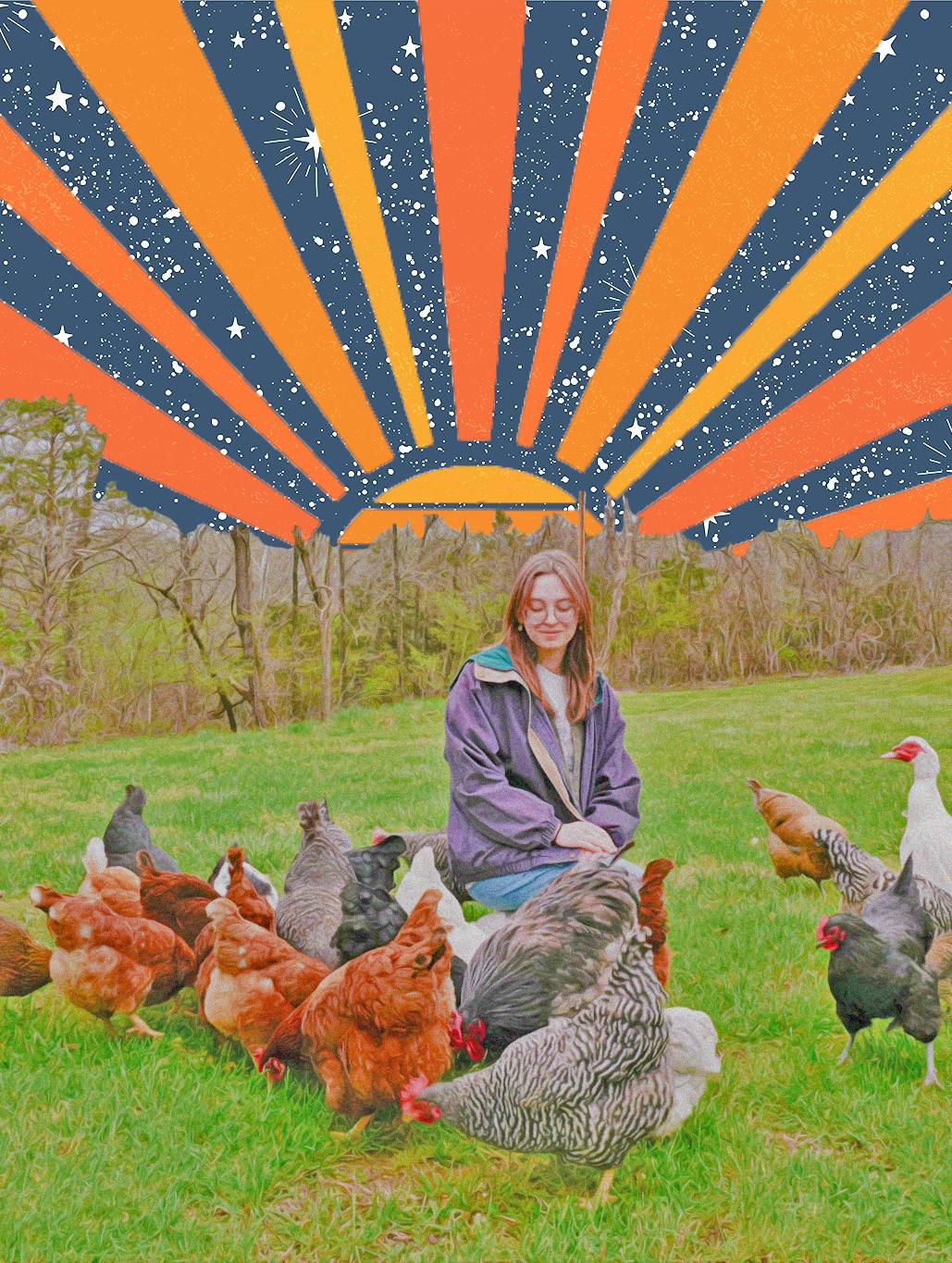
HOMESTEAD DREAMS
Meet the locals making a home with their own hands. PAGE 12
HERDING THE LAUGHS PAGE 9
CREPES WITH YOUR COFFEE PAGE 27
WORKING WITH WORMS PAGE 33
THE VOICE OF COLUMBIA MAY 2024


Pedaler’s Jamboree - 15th anniversary May 25 & 26, 2024 - Columbia, MO
Let's ride! Join a slow paced 2 day music festival adventure on the Katy Trail! 2 days of bike riding, music & festivities! 30 miles each day on crushed limestone trails. All ages and abilities welcome!
Featuring an all Missouri lineup: Ha Ha Tonka, Hooten Hallers, Spooklights Aaron Kamm & the One Drops, Fireworks, Molly Healey String Project & many more!
Let the good times roll!
REGISTER TODAY: PEDALERSJAMBOREE.COM
MISS INDEPENDENT
At this point in my life, I’m relying on myself in a way I never have before. After graduating from Webster University a year ago, I left my hometown, St. Louis, and moved to Columbia all on my own.
I moved into my first non-campus apartment and knew I would have to depend on myself — but for real this time. I’ve never paid bills (unless you count Apple Music). I used to be terrified of driving and now I drive every day. I have to feed myself and go to the grocery store since I don’t have a meal plan. I used to run track during undergrad, but now I have to motivate myself to be active on my own. At the same time, I’m learning lessons fundamental of adulthood.
Being independent for the first time is hard, but I feel more empowered than ever before. Our feature package on homesteading (p.12) is all about self-sufficiency and highlights people who find joy in providing for themselves. From raising farm animals to crafting their own soap and deodorant, these individuals bring autonomy to a new level.


Being self-reliant is a blessing. One story that touched my heart highlights Anita Dye (p. 34), someone who experienced homelessness and addiction. After Dye became sober and got her own apartment, she couldn’t believe it was all real, and all hers.
Self-sufficiency can branch into new opportunities. When Marika and Sara Estrapala started learning the craft of woodworking (p.11), they were interested in creating items that at the time were financially inaccessible to them. We also see more woodworkers who value the personal touch they have on their work, which translates into their businesses.
The next time I get stressed about my utility bill being high or having to stop for gas after a long day of meetings and classes, I hope to remember stories like these. Relying on yourself isn’t just about surviving, it’s about taking pride in what you can do for yourself. The people we see in this issue show us the joy that comes with that pride.

MICAH BARNES
Editor-in-Chief
Behind the issue
When it was suggested that we bring back the Vox Voice podcast this spring, I wasn’t sure what to expect. It had been nine months since the last episode, which was before my time with the magazine. Yet, after listening to old episodes and seeing what Vox Voice was, I quickly understood the podcast’s roots. It’s a show meant to encourage connection in the Columbia community — a way of saying “Hello, neighbor” and an invitation to learn about fellow locals. Knowing this, it became my goal to channel that charm into each episode. I thank the guests who joined us for the upcoming season and my amazing multimedia team of Jack Copeland, Olivia Maillet and Abigail Zorn. They put in the major work to make it happen. Watch for Vox Voice April 26 wherever you get your podcasts.
—Dominique Hodge, multimedia editor
CULTURE SOPHIE CHAPPELL, CHLOE LYKKEN, COLE MILLER, KHALIA SMITH, JULIA WILLIAMS
EAT + DRINK AVA GOUGH, JADEN HARPER, MOLLY
RHODES, IAN WESSELHOFF, CAYLI YANAGIDA
CITY LIFE BETH BURTON, KARA ELLIS, EMILY ANNE GRIFFITH, ANDREA MERRITT
STAFF WRITERS SAM BARRETT, GRACE BURWELL, LEVI CASE, SARAH GOODSON, OLIVIA MAHL, ABBY RAMIREZ, SAVVY SLEEVAR
SOCIAL & AUDIENCE DIA GIBBS, MIKAYLA HIGGINS
DIGITAL PRODUCERS JACK COPELAND, EMILY BOYETT, BRIANNA DAVIS, SARAH GASSEL, AMELIA HURLEY, OLIVIA MAILLET, KATE RAMSEYER, SHIRIN REKADBAR-XAVIER, JACOB RICHEY, NATALIE SMITH, ABIGAIL ZORN
CONTRIBUTING WRITERS MADISON ARENAZ, ATHENA FOSLER-BRAZIL, KEARA CONNOLLY, MAYA DAWSON, AUDREY ELLIS, BRIANA IORDAN, OLIVIA MAILLET, MARY RUTH TAYLOR, NICOLE VOSS, ELLIE WEIEN
DESIGNERS CAITLIN KANE, GABBY NELSON, MAGGIE POLLARD
ART ASSISTANTS THEO JOHNSON, VALERIE TISCARENO
EDITORIAL DIRECTOR HEATHER ISHERWOOD
EXECUTIVE EDITOR LAURA HECK
WRITING COACHES CARY LITTLEJOHN, JENNIFER ROWE


3 VOX MAGAZINE • MAY 2024
Photography by Lily Dozier and Jack Copeland
Olivia Maillet (left) samples fare from the Dada Döner food truck.
ADVERTISING 882-5714 | CIRCULATION 882-5700 | EDITORIAL 884-6432 Vox Magazine @VoxMag @VoxMagazine @VoxMagazine CALENDAR send to vox@missouri.edu or submit via online form at voxmagazine.com WANT TO BE IN-THE-KNOW? Sign up to receive Vox ’s weekly newsletter, the “Vox Insider.” We’ll tell you how to fill up your weekend social calendar and keep ahead of the trends. Sign up at voxmagazine.com. FOLLOW US MAY 2024 VOLUME 26, ISSUE 4 PUBLISHED BY THE COLUMBIA MISSOURIAN LEE HILLS HALL, COLUMBIA MO 65211 Cover design: Campbell Biemiller Photography: Jamie Maron and Adobe Stock EDITOR-IN-CHIEF MICAH BARNES MANAGING EDITOR MEGHAN LEE DEPUTY EDITOR HOPE DAVIS DIGITAL MANAGING EDITOR MJ MONTGOMERY ASSISTANT DIGITAL MANAGING EDITOR MAE BRUCE AUDIENCE ENGAGEMENT EDITOR DAVID TALLANT CREATIVE DIRECTORS CAMPBELL BIEMILLER, AVA HORTON PHOTO DIRECTOR LILY DOZIER
EDITOR DOMINIQUE HODGE
MULTIMEDIA
ASSOCIATE EDITORS


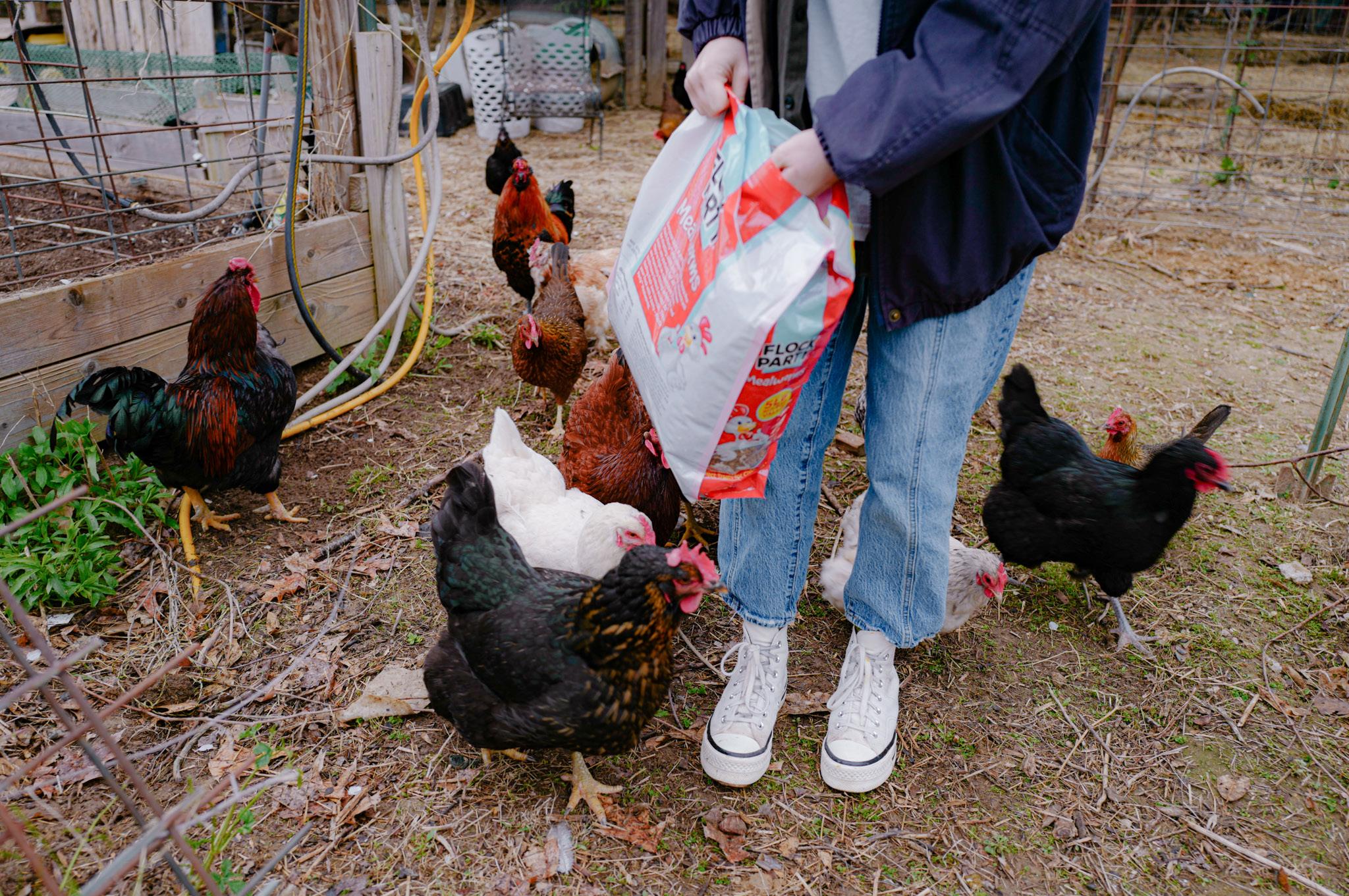



4 VOX MAGAZINE •MAY 2024
29 27 TABLE OF CONTENTS 05 IN THE LOOP 05 Queen of the castle Jiya Shetty wants to change the world — one chess game at a time. 07 Vox Picks Find out about recent grand openings, poetry readings and bi-annual markets. 08 It’s a döner delight Vox talked to Vahap Ulker, the owner of Turkish food truck Dada Döner. CULTURE 09 Off their reins Get backstage access to the short-form improv group, The Ponies. 11 Rooted in tradition Meet four local woodworkers crafting functional and unique pieces FEATURES 12 Homestead revival Discover where these homesteaders live, and what they live for. EAT + DRINK 27 Batter up! Acola Coffee Company and eat.crepe. love now share a home. 29 Get yourself a treat Need a quick snack? Here’s a list of six little treats for $6 or less. CITY LIFE 31 Ask, then speak Learn how to talk about autism and nuances with inclusive language. 33 Scraps to soil Make the most out of your compost with these organic tips. 34 Road to recovery Anita Dye was a client at Room at the Inn. Now, she works there. 12 09 31
Photography by Lily Dozier, Halle Paulus, Halle Paulus, Catie Cobble, Cara Penquite, and courtesy of Beet Box



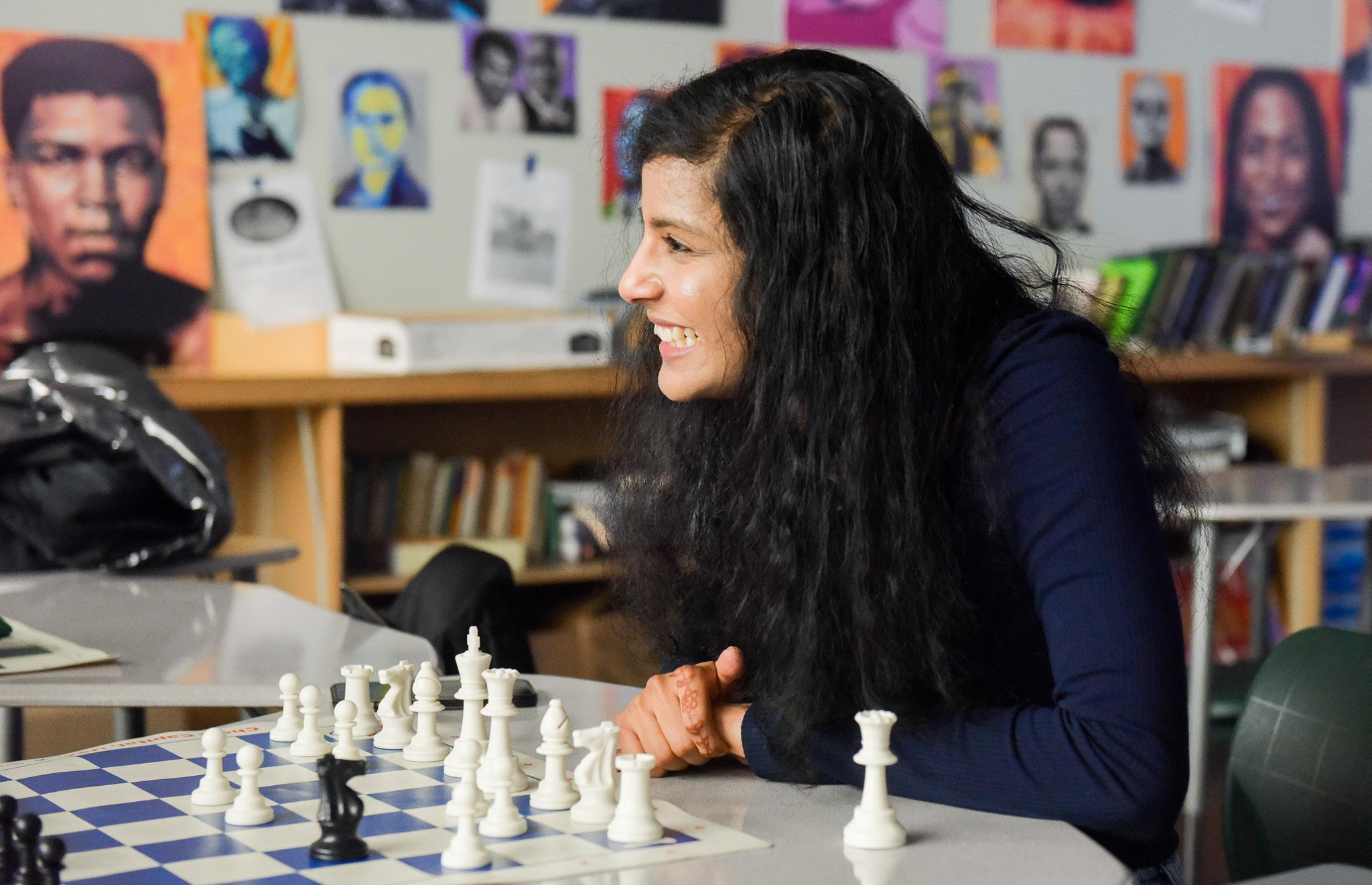
Queen of the castle
This Rock Bridge High School student shares the benefits of chess with others.
BY SAM BARRETT
Jiya Shetty started playing chess in fifth grade, after her younger sister picked up the game and beat her one too many times. Many lessons, clubs and competitions later, the high school junior says this strategic game has helped shape her into who she is today.
“Jiya is probably one of the most driven high school students I’ve ever met,” says Drew Shattuck, Shetty’s former teacher. Shattuck is the former president of the University of Missouri Chess Club and former player for the Mizzou Chess Team.
Shetty has been president of the Rock Bridge High School Chess Club for two years now. Under her leadership, the club has doubled in size.
“Jiya has always been one that’s willing to talk to other people and try and encourage other kids to play,” says Tim Campbell, owner of Mid-Missouri Chess Academy and Shetty’s long-time private coach.
Now, she’s trying to bring chess into senior centers with Mindful Chess, an organization she founded. Shetty discov-
ered new inspiration in her sophomore year of high school when she started her research for the Congressional App Challenge. She and her partner, Drew Romitti, created Dementia Doctor, an app that uses artificial intelligence to diagnose dementia.
During the creation of this app, Shetty came across numerous articles about the benefits of playing chess or similar community-driven, strategic games as a method of preventing dementia and Alzheimer’s disease. Shetty,
5 VOX MAGAZINE • MAY 2024
IN THE KNOW P.7 FOOD TRUCK FARE P.8
Photography by Catie Cobble
Chess Club President Jiya Shetty plays a game against her friends. “Jiya is the chess queen,” says Shetty’s friend, Nora Sehneider.
GET ON BOARD
Want to get into chess, mate? There are scores of local resources to help.
Daniel Boone Regional Library
The library hosts events for players of all skill levels. Visit dbrl. org/events. The library’s YouTube channel also has beginner resources or you can access free instruction with a library card through Brainfuse and Kanopy.
CoMo Chess Club
This group meets 6-9 p.m. Thursdays. Follow on Facebook or email comochess@ gmail.org.
MU Chess Club
Meetings are held Mondays and Thursdays. For inquiries, visit sites. google.com/site/ umcchess.
North American Chess School
This national organization provides group chess training. Visit nachessschool.com for more.
who was 10 when her grandmother died due to Alzheimer’s, decided to further her research.
“I wanted to kind of spread this idea that chess is not only just a game,” Shetty says. “But it can help you in your health as well and can help prevent a very severe disease such as Alzheimer’s.”
Shetty created Mindful Chess in 2023 to share the fruits of her research, and is hoping to get it up and running by this summer. The first move is creating chess lesson plans. She intends to teach these lessons herself, but she’s also in search of material donations and knowledgeable volunteers to help support her goals.
Longtime players like Shetty, Shattuck and Campbell are passionate about getting their community involved because of benefits they know it provides.
Shattuck says if you want to be serious about the game, you have to study it, which in turn builds better study habits for students. The critical thinking aspect of the game has helped students plan ahead and has also assisted Shattuck in planning next steps in his life.
Campbell says it benefits him as he gets older by keeping his mind sharp. He has also noticed that his students’ confidence improves the more they play, whether that’s more confidence in competitions or in their decision making.
Shetty says this game has helped shape her personality through its capability to constantly challenge her mind and get her in touch with her commu-

Jiya Shetty reaches for her queen. This is her second year as president of the Rock Bridge High School Chess Club.
Jacob Beaman (left) picks up a piece as Alex Libault watches. The Chess Club meets every Tuesday under Drew Shattuck, a first-year teacher at Rock Bridge High School.
nity even when that seems impossible.
“During the COVID-19 pandemic, whenever The Queen’s Gambit came out and other TV shows like that, chess became a lot more mainstream,” Shetty says. “That’s one thing I really liked about it, because there’s so many people, even online, that you can play chess with. That really kind of helped me get through the pandemic.”
All of the players agree that in addition to the game’s benefits, it’s also a community builder. They want to unite the community through a game that can change their lives for the better.
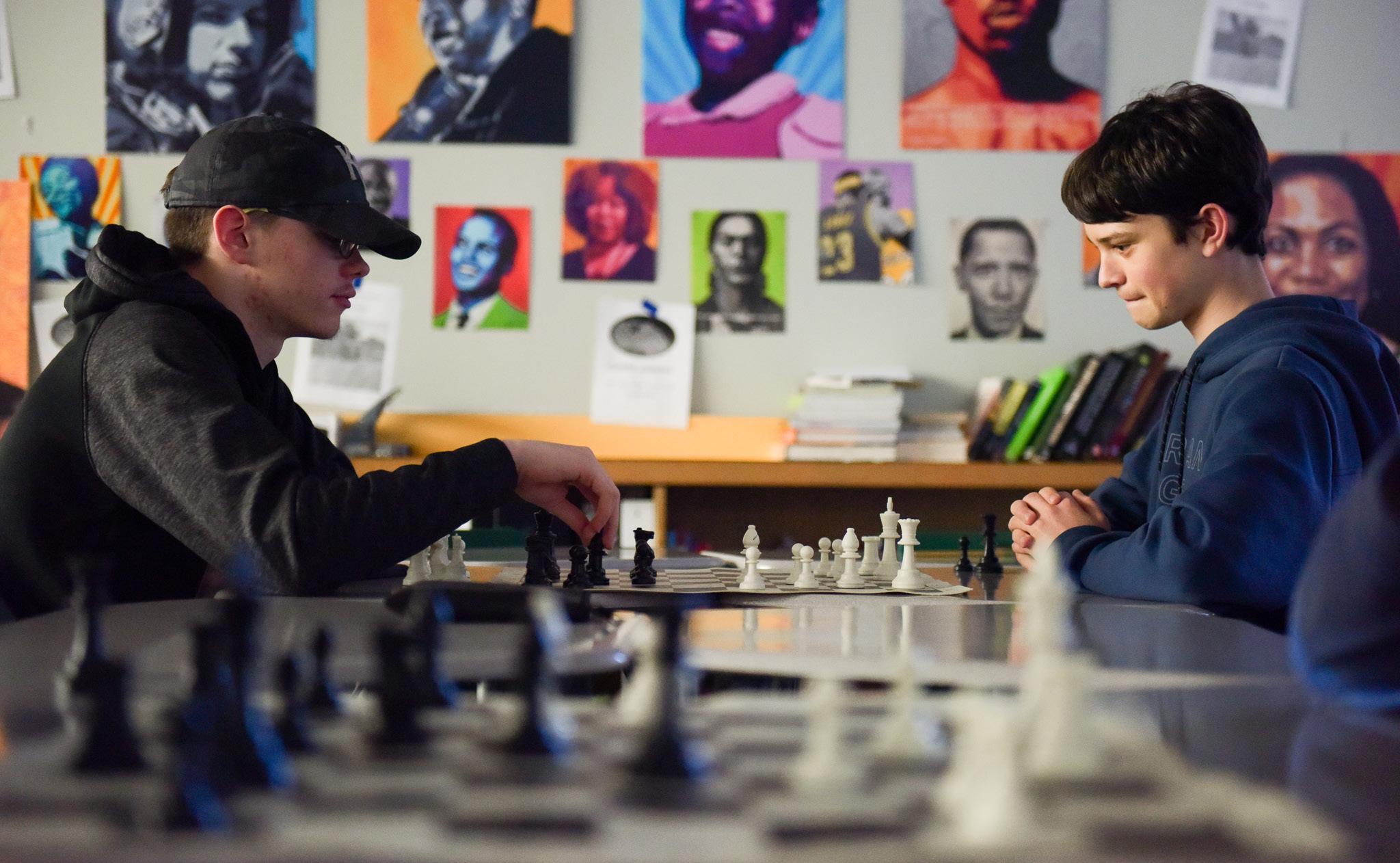
TEST YOUR SKILLS
The Missouri Chess Association holds nationally rated tournaments in the state. Visit mochess.org for information. Two upcoming events include: Springfield Chess Club This tournament on May 10 follows a lecture by National Master Bob Holliman at the Springfield Chess Club. Competitors must be U.S. Chess Federation members.
Rolling Hills Library
On June 8 in St. Joseph, this event offers one open play tournament and another event limited to chess federation members.
IN THE LOOP PEOPLE
Photography by Catie Cobble
Vox Picks for MAY
Each month, Vox curates a list of can’t-miss shops, eats, reads and experiences. We find the new, trending or underrated to help you enjoy the best our city has to offer.
BY SOPHIE CHAPPELL, COLE MILLER AND CAYLI YANAGIDA

DANCE while celebrating the reopening of The Penguin Piano Bar & Restaurant. The original Penguin closed four years ago during the pandemic, but the beloved nightclub is back with a twist. Now including more music, cocktails and a full restaurant menu, The Penguin hopes to honor its legacy while returning with a new and improved look. Early in the evening, professional pianists set a gentle ambiance, but turn up the heat later in the night and duel with the keys. Grab a drink or a meal, or just enjoy the live piano. The Penguin Piano Bar & Restaurant, 1025 Broadway, Wed-Sat, 4-9 p.m. for all ages, 9 p.m. to 1 a.m. for 21+, penguincomo.com, 573-449-8005
SHOP at the biannual Loop Maker Market. The many arti sans, cooks, makers and crafters will have gifts perfect for Mother’s Day or just because. Items are handcrafted and “one of a kind,” according to The Loop’s website. Get Mom a special pair of earrings and support a local artist all at the same time. Interested makers can still get a free booth at the market by contacting Rae Adams. 10 a.m. to 1 p.m. May 5, Loop PopUp Park, 807 Business Loop E., info@theloopcomo. com, 573-443-5667


INDULGE in a hearty bowl of pho, a delicious bánh mì sandwich or fried bananas at Pho Quan Viet Cuisine’s new location. Pho Quan shut its doors in January after nine years on Vandiver Drive. Now, after months of construction, the new restaurant on Paris Road is ready to welcome hungry customers for the grand opening on May 15. Boasting a large dining room and an expanded menu of Asian-American staples and traditional Vietnamese fare, Pho Quan’s new location will be a great place for a hearty meal. Pho Quan Viet Cuisine, 2016 Paris Road, Pho Quan Viet Cuisine on Facebook, 573-449-0504

LISTEN to powerful poems presented by the Columbia Writers Guild, Mizzou Students for Justice in Palestine, Mid-Missouri Fellowship of Reconciliation and the University of Missouri MSO. Hosted at Cafe Berlin, Soul of Our Soul will be an evening of poetry dedicated to those whose lives have been affected by the ongoing conflict in Palestine. Admission to the reading is free, but donations are encouraged. Interested readers can also help out by buying literature. The event will serve as a platform to raise funds for humanitarian aid. 6 p.m. April 30, Cafe Berlin, 220 N. Tenth St., free, cafeberlincomo.com, 573-441-0400
VIBE with EleveN2wenty2 and other artists at Soul Sessions CoMo’s monthly music and arts showcase. Local artists host the show along with house band, The MO’ Soul Collective. Artists in the community and abroad join in the fun of performing originals and covers, but it’s not just about the music. There will also be an art exhibit, spoken word performances and dances. You can take something home with you, too. Local minority-owned businesses will have booths for visitors to browse. 8 p.m. May 31, The Blue Note, 17 N. Ninth St., thebluenote.com, 573-874-1944


IN THE LOOP VOX PICKS
Photography by Caroline McCone/Archive and Katie Kriz/Archive and courtesy of Adobe Stock
It’s a döner delight
The idea for Vahap Ulker’s Dada Döner food truck has been marinating for a long time.
BY OLIVIA MAILLET
Vahap Ulker moved from Turkey to the U.S. in 2006 when he was 20. While he was living in Louisville, Kentucky, he wanted to bring Turkey to his new home, so he started making döner. Now, he shares this traditional cuisine with Columbians from the back of his food truck, Dada Döner.
Döner, a meat cooked on a spit, has roots in the Ottoman Empire, but the style of food appears in many cultures. In Mexico, it’s pastor; in Greece, it’s the
For an episode of Vox Voice, Ulker talked about Dada Döner’s origins, and what’s next for the food truck.
How did you get started with the food truck?
In Louisville, I attended some festivals without the food truck — you just basically set up the tent from the festival — and then I got great feedback. I said ‘OK, I am ready for a food truck.’ Now I am on that step.
Here’s my philosophy: If you’re going to do anything in this life, any business, any project, whatever, first you need to count on yourself, because you know that always things can go wrong and people can change their mind.
How did you learn to make döner?
I’ve been working on this project, actually, since 2016. I’m not a professional cook, but I can learn one thing really good and then work on that.’ So that’s how it really started. Then I got to work
VOX VOICE
The ninth season of the Vox Voice podcast, including Vahap Ulker, launches April 26. Listen wherever you get your podcasts.
with people that are really expert on this. I worked for free with them whenever I went back to my country.
It is intense, because you need to have this vertical broiler and more special equipment, so you don’t really cook it at home. And then the way they cut things, the spices, the marination, all that is of course you need to have some experience.
What do you enjoy most about the food truck?

Vahap Ulker has a lot more than chicken döner on his plate. He splits his time between a University of Missouri job and the food truck he and his wife, Vahide, run while also parenting son Miran.
I love when I see people coming to the food truck and then we start to recognize each other, and then people kind of get to know each other while they’re waiting for their food. And then some little conversation, little jokes, just makes your day. It’s not just the food actually, it’s about the environment.
That’s another (reason) why I wanted to start this business, too. Because here, especially in the United States, everything happens so fast. We just basically focus on our studies, work, whatever you do, and then we eat so fast. It’s not really that important — just go grab something and then do your work. But what are the things we really enjoy in this life? Food is one of them, as you should take your time and then really enjoy those moments.
What’s the future for Dada Döner?
The next step will be, hopefully, a restaurant. Now I’m in that position to see the residual reaction and what people say.
(Editors note: Ulker says he’s planning to open a restaurant in the former Quarry location.)
I don’t want this to happen just about business, about money. I just think I want this thing to be something more than that — give people some good memories at same time.
Jack Copeland IN THE LOOP Q&A
8 VOX MAGAZINE •MAY 2024



Off their reins
The Ponies celebrate five years of laughter as Talking Horse’s resident short-form improv group.
BY SARAH GOODSON
Five years ago, Adam Brietzke started an improv group just because he loved it. Since then, The Ponies have grown into a group of 17 diverse individuals with an undeniable passion. The group shows their love for improv the first Friday of every month at Talking Horse Production’s small blackbox theater.
Rows of couches and chairs face the performance stage, welcoming guests to relax. The group’s improv shows create an intimate space for audience members to enjoy lighthearted comedy.
Brandt Shields, a first-year Ponies member, says the group’s variety of personalities enhances their shows. “Improv is really based on personalities, and what makes our group so unique is that we have such a diverse set of backgrounds,” Shields says. “A diverse set of jobs, of personal lives, that when you combine all those different things together, really funny stuff comes out.”
Similar to Shields, Brietzke says that his favorite part about The Ponies is less about the shows, and more about the team of actors, the community and bringing joy to others. “Sometimes people just need to laugh,” Brietzke says. “Especially in this day and age, where everything seems so dark and ominous. If we can bring some joy to people, then we’re doing pretty good.”
Brietzke brings improv and community involvement together. In addition to his involvement with The Ponies, Brietzke is the development
9 VOX MAGAZINE • MAY 2024
Photography by Lily Dozier
P. 11
GOING WITH THE GRAIN
The Ponies put on a high-energy improv show every first Friday at Talking Horse. Jerrica Leonard mimes packing Lauren Peck’s nose with sand to prevent a charade nosebleed in March.

director at Big Brothers Big Sisters, a mentorship program for kids. The Ponies formed a bowling team that raised over $2,000 as part of a fundraiser for the program.
Jerrica Leonard, one of the very first Ponies, has found her experience to be particularly rewarding, especially because of its community involvement. “Just knowing that there are folks out there who care so much about that sort of cause, and think
Jerrica Leonard and Krescenz Hundley play a game called four square during a Ponies show.
TROT OUT TO SEE THE PONIES
WHEN
Every first Friday, 7–9 p.m. Talking Horse Productions
210 St. James St. $10 in advance: $15 day of poniesimprov. com/shows
about us when they made the charitable donation,” Leonard says. “That’s really nice.” Father-daughter duo Robert and Alice Klick have attended several Ponies performances. Alice takes theater classes at Theater Reaching Young People & Schools, a not-for-profit children’s theater program. Robert says that a Ponies show is a great way to spend a Friday night. “It really takes a lot of guts going up there and to be funny on the spot,” Ponies member Adam Brietzke prepares the audience before an improv show at Talking Horse Productions.
Robert says. “It’s fun to see the hard work come together. We just come out and just have a good time; it’s a good way to relax.”
Both on and off the stage, the improv group provides a space for its members and audience to sit back and laugh.
“My degree is in theater, but it’s not something I get to do on a daily basis,” Shields says. “And I can be creative, I can find that outlet. That’s really special to me.”


10 VOX MAGAZINE •MAY 2024 CULTURE COMEDY
Photography by Lily Dozier

Rooted in tradition
Woodworkers carve passion, family ties and experiences into their craft.
BY GRACE PANKEY
In a world of cheaply manufactured wood furniture and mass-produced home goods, Columbia woodworkers combine artistry and technical skill to create one-of-a-kind pieces that are both functional and beautiful. Meet four local artisans in Columbia’s woodworking community.
Estrapala Woodworking estrapalawoodworking.com
Functional art
In 2020, Marika and Sara Estrapala founded Estrapala Woodworking. When they moved to Columbia a few years earlier, neither had previous experience with the craft. Sara Estrapala started using woodworking as a way to relieve stress and also create items that were financially inaccessible to them at the time. Eventually, they both took classes at Sawdust Studios, and continued working at their newly discovered passion.
They currently are the only two female members of the Midwest Woodworkers Association. They focus on functional arts. Their most popular items are wooden cake knives for weddings.
Galaxy Woodworks galaxywoodworks.com
Laser engraving and custom design
Personalizing gifts is one of the many joys of woodworking for Phillip Chisholm of Galaxy Woodworks. The craft came naturally for Chisholm because of his creative inclinations.
Chisholm uses a laser engraver to add detailed images to wooden pieces. As an Air Force veteran, he especially enjoys creating humidors — a storage container for cigars — for other veterans. Every piece Chisholm creates is unique and can be personalized. Most of Chisholm’s materials are sourced locally.
Mark Hall Fine Cabinetry
markhallcabinetry.com
Cabinetry
Jack Hall, vice president of Mark Hall Fine Cabinetry, is part of his family’s fourth generation of woodworkers. His grandfather owned a woodworking shop in Rocheport. Before that, his great-grandfather started a shop in Los Angeles. Jack’s father, Mark, started the cabinet business in Columbia in 1995.
Hall fell in love with woodworking because of wood’s forgiving properties and creative potential. He says wood is generally softer than other materials used in constructing and crafting, and mistakes can be easily fixed.
Hall’s mother, Stephanie, also works in the shop. The family dynamic makes work easier, Hall says. “Everybody in the shop cares about each other and if somebody’s gone you can really tell that there’s a missing link.”
Rolfes Woodworking & Design
@rolfeswoodworking on Instagram
Laser engraving & custom furniture
Kyle Rolfes is also a fourth-generation woodworker in Columbia. He grew up hanging out in his family’s shop and helping on small projects.
upcoming project. The pieces can be customized to fit the needs of every customer. Sara and Marika Estrapla are both self-taught woodworkers. They began by taking local classes, which encouraged their creativity and eventually led to their business.
After college, he started making custom furniture pieces, which was the beginning of his business. He says he loves the versatility that woodworking offers. He has made frames for paintings, furniture, dice trays for table top games and other intricate tables. He prides himself for being sustainable in his work and locally sourcing the wood.
“I know exactly where the wood I build for my furniture comes from, and in some cases, I’ve actually cut down the tree that I’ve used the wood from to build that furniture piece,” Rolfes says. “I have the privilege to see that process from standing over a tree to a wonderful piece of furniture that hopefully lasts 100 years for someone.” All of his pieces are both customizable and personalized.

11 VOX MAGAZINE • MAY 2024 CULTURE ARTISANS
Photography by Elena Fu and Kennedy McGilvery/Archive
Jeremy Davis of Mark Hall Fine Cabinetry spray paints wooden boards for an
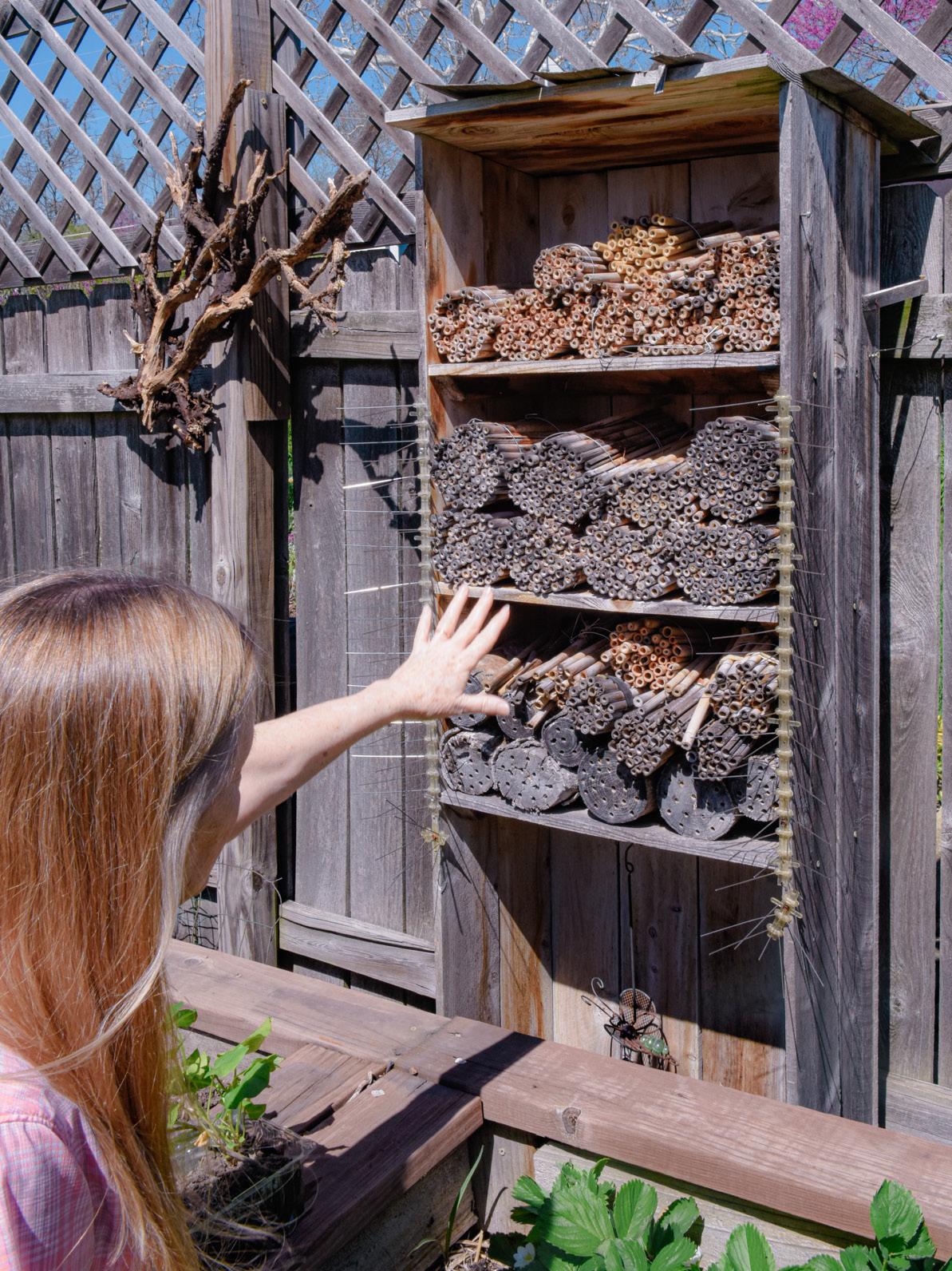
VOX MAGAZINE • MAY 2024
Photography by Nick Ginter
12
Matt Knowlton built his wife Kathy Doisy (below) a native bee hotel. It’s made from an old shelf and bamboo sticks, and sits in their extensive garden. Bees will hibernate or shelter in the hotel.
HOMESTEAD REVIVAL
IN THE U.S., HOMESTEADING HAS A HISTORY STEEPED IN COLONIALISM. BUT SINCE THE 1960S, IT HAS MORPHED INTO AN ETHOS OF SELF SUFFICIENCY — ESPECIALLY IN TIMES OF UPHEAVAL.
BY ATHENA FOSLER-BRAZIL
The term “homestead” evokes many images: log cabins nestled in remote locations, vegetable gardens brimming with produce, farm animals milling around acres of land, shelves stacked with canned goods and loaves of fresh bread. While homesteaders of yore were self-sufficient out of necessity, a back-to-the-land ethos has existed as long as cities.
Today, people can pick and choose which homesteading practices they want to integrate into their lives based on what works for them, with online resources and social media increasing the accessibility and visibility of self-sufficiency. Some popular social media homesteaders project a conservative ideal through the “trad wife” trend, in which women create content depicting themselves as the ideal self-reliant housewife. But, homesteading is much more than that.
Jason Strange, an associate professor at Berea College in Kentucky and author of Shelter from the Machine: Homesteaders in the Age of Capitalism, describes the intentional return to homesteading and self-sufficiency as a form of activism and resistance.
Beginners don’t need land or a lot of time to do a little homesteading. Whether it’s planting an herb garden on a balcony, learning to sew a button or trying a sourdough recipe from Instagram, there are countless ways to increase your sufficiency.
A brief history of American homesteading Homesteading in the United States has a brutal history. The Homestead Act of 1862, signed into law by Abraham Lincoln, privatized 270 million acres of land and destroyed Indigenous
societies. Settlers wishing to file a claim only had to pay $18 in fees (just over $550 today) for 160 acres of “unclaimed” land. According to the National Park Service, native tribes were forced to turn over their land to the U.S. government and were confined to reservations as their territories and resources were taken over by American homesteaders.
“It’s a highly settler-colonialist concept where land that’s not being ‘properly cultivated’ in the European sense is kind of up for grabs,” says Jeffrey L. Pasley, a University of Missouri professor and Kinder Institute chair of Early American History.
Pasley says the Homestead Act was part of an effort by the Union during the Civil War to offer land to the working poor to prevent it from being cultivated by slave owners. In the beginning, homesteading in America was explicitly political, aimed at commodifying land the government wanted to control.
Although the homesteaders of American history lived in an overtly colonial and patriarchal society, Strange says people and cultures across the world have organized backto-the-land movements. The desire to be closer to nature and become more self-sufficient often coincides with times of social, political and economic unrest. The homesteading ethos particularly resonated with Americans during the 1960s and ’70s. A 1975 New York Times article described the aim of the movement as living off the land “outside the economic institutions that dominate the United States.”
“One of the most striking things about homesteading is that it seems to be something that appears as a kind of strategy that can, at least to some extent, serve as resistance against almost any fear you have,” Strange says. Whether your concerns
VOX MAGAZINE • MAY 2024
13
DESIGNED BY: Campbell Biemiller
EDITED BY: Emily Anne Griffith, Ava Gough and Julia Williams
are social, environmental, religious or economic, returning to the land and becoming more self-sufficient are ways to assuage some of those fears. And since 2020, when the world was thrown into chaos by the COVID-19 pandemic, many found solace in devoting time to the domestic sphere.
Homesteading without a homestead
In February, Mik Kuehnel and Lindsey Cunningham built a 6-by-8-foot greenhouse in their Columbia backyard. Even though they don’t come from agricultural backgrounds, the couple found their way to gardening on their own. Kuehnel and Cunningham are both interested in science and have an affinity for the outdoors, but gardening at home also has practical benefits.
“We cook at home most nights of the week, and it’s usually cooking from scratch,” Kuehnel says. “We do have to buy all the ingredients, and a lot of it is produce, which is expensive, so it’s nice to just have it.” The couple is also trying to eat more seasonally. Growing their own food helps them do so while staying in touch with the environment.
Engaging in homesteading activities is one way to take intentional steps to increase the subsistence portion of the household economy, whether that means learning to fix a leaky faucet yourself or mending a hole in a pair of jeans. “It is possible for individuals or families to engage in homesteading just a little bit,” Strange says. “I think, generally, people find it really satisfying. You’re gaining real-world skills, you’re doing tasks and chores that you can be proud of.”
Increasing self-sufficiency can also allow you to live more sustainably. Eating in season, fixing worn or broken items and cultivating gardens all have positive environmental impacts.
Benefits of homesteading
“There are a lot of reasons why it feels good to touch soil,” Cunningham says. “It just makes sense, it’s intuitive, and it’s also nice to feel more connected to
the place you’re in.” Cunningham is particularly excited to be growing loofah, one of about 25 plants they’re cultivating this year. Once the gourds are ready, Cunningham and Kuehnel will dry them, shake out the seeds and cut them into pieces to be used as sponges.
For Kuehnel and Cunningham, working in the garden also helps them clear their minds and decompress. A 2018 article from the Royal College of Physicians cited multiple studies that found gardening and spending time outdoors is linked to improved mood, lower anxiety and better health outcomes. According to the World Economic Forum, engaging in domestic chores is linked to better memory and physical strength in older adults.
Additionally, a strong sense of self-sufficiency contributes to feelings of security and well-being, according to a 2013 article in Psychology Today. The article explains that self-sustaining individuals are more resilient and feel more control over their lives. Engaging in activities that increase self-sufficiency, regardless of how small, can build self-esteem and confidence.
Fifty years ago, if you wanted to raise animals or preserve food, you did so in the privacy of your home without any way of reaching a large audience. Today, we find homesteading content on apps like TikTok and Instagram. This access has shown people that it’s possible to do small things in small spaces with little time. Information about everything from baking bread to raising chickens is more accessible than ever, and taking steps toward self-sufficiency has real economic, environmental, emotional and mental benefits.
In this package, Vox explores different ways that locals incorporate homesteading practices into their lives. You’ll meet a couple who makes goat milk products, a student who oversees a mini egg empire, a woodworker building his family home and a woman who has kept up a garden for 40 years. You’ll also learn ways to try self sustainability with advice about cleaning, canning and gardening.
VOX MAGAZINE •MAY 2024
14

BUILDING
He builds with his heart
WOODWORKER, HUSBAND AND FATHER OF THREE CRUZ CHAVEZ LOVES WORKING WITH HIS HANDS AND TEACHING OTHERS TO DO THE SAME.
BY SAVVY SLEEVAR
On a 9-acre stretch of land near the winding gravel byway of Hinkson Creek Road, a forest used to run wild. Thick with trees and gangly brush, the land appeared rugged and impenetrable. “It looked like only a crazy person would build on that property,” Cruz Chavez says. But this land was exactly what he and his family wanted. After clearing a bevy of trees and five years of hard work, a home emerged.
The family moved out of their two-bedroom apartment and onto the property in December 2023. In the following months, they prepared the backyard for grass seed and constructed a chicken coop. The property’s focal point is the house Chavez built — a multi-tiered layer cake of a home with roof panels angled every which way.
Several features make Chavez’s house one-of-a-kind. “All the siding is from trees within 50 feet of the house,” Chavez says. The ash wood he used to construct a floating staircase and the
white oak wood for the front door also came from the surrounding forest. These wood accents will soon be joined by ash cabinetry and a kitchen table that Chavez’s wife, Brooke, will build.
Perhaps the home’s most intriguing detail isn’t a wooden statement piece, but a piece of perspective: If Chavez hadn’t embraced his love for building, this home wouldn’t exist.
Laying the foundation
As a teenager, Chavez was constantly building things, including a bookshelf still in his mother’s home. Despite his handiness, everyone in Chavez’s life assumed he’d become a doctor because he excelled academically. He was discouraged from taking shop class in high school, and he threw himself into Advanced Placement courses instead, earning dozens of college credits before enrolling at the University of Missouri — pre-med, of course.
“I think I would be an amazing doctor, but I would also be miserable,” Chavez says. “Because I would be wanting so badly to get to the point in my life where I could work with my hands.”
Chavez became disinterested in the prospect of medical school and took a construction job after graduating with a degree in biology from MU in 2012. The job allowed him to discover how mechanically gifted he was.
Putting down roots
After a few years in the industry, Chavez launched Cruz Custom Construction at 25. And he didn’t stop there. At 30, Chavez founded Sawdust Studios, a community wood shop that invites people to learn woodworking skills and use specialized equipment that might otherwise be inaccessible for builders on a budget.
Kate Loftin, Sawdust’s shop manager, didn’t begin her woodworking journey until adulthood either. She became an apprentice at a Springfield wood shop in 2019. When her grandfather died in 2020, she inherited some of the machinery he used to build intricate wooden birdhouses and chess boards.
VOX MAGAZINE • MAY 2024
Photography by Cara Penquite
15
Cruz Chavez built this home for his family of five in a forest off Hinkson Creek Road.

TAPE MEASURE
CARPENTER PENCIL
Want to be handy but don’t have the hardware? From simple repairs to crafty DIYs, Chavez suggests these essential tools for home maintenance projects.
For home projects, you’ll want one that measures at least 16 feet.
$5
These wide, flat pencils don’t roll away while you work. Use them to draw lines to know where to cut a board or mark the spot for a nail. 20 cents
SQUARE Squares help ensure the perfect angle before cutting building materials. Chavez says a 7-inch model should do the trick. $10
6-IN-1 SCREWDRIVER
Magnetic swappable bits make this handheld tool perfect for almost any screw. $8
VOX MAGAZINE •MAY 2024
Photography by Cara Penquite
HAMMER Chavez recommends a steel 18-ounce claw hammer, but they come in a variety of weights for different projects. $5-$15
16
Throughout her early 20s, she’s continued to develop her woodworking skills. “I like the idea of just being able to pay attention to detail, slow down and pursue a craft, and then you get a really beautiful product,” Loftin says.
When leading a class felt daunting to Loftin, Chavez’s training and encouragement emboldened the 24-year-old builder. “I think Cruz is really good about, like, ‘You just gotta do it,’ ” Loftin says. “Teaching has been the best form of learning for me, and so the more opportunities I’ve had to learn over time, the less intimidating it’s gotten.”
More than a carpenter
Chavez doesn’t just guide experienced woodworkers like Loftin. Chavez’s children, Violetta, 7, Ezra, 5, and Luca, 3, have all found their niche in the shop. From Violetta’s artistic projects to Luca’s desire to bang a nail into a board, Chavez hopes they at least know how to make quick fixes and live independently.
“I want their perfect day to somehow end up with them sitting at the table with their family, laughing and smiling,” Chavez says. That’s his vision for the wood shop: focusing on things in life that really matter. “Building a kitchen table really is us getting ourselves closer to that dream,” Chavez says. “This is the table that I want to sit at and laugh at and argue at. Our life should be happening at this table.”
Try
“I want my daughter to feel like if she needed to cut a 2-by-4 to 4 feet to brace something in her house, she could pick up a circular saw and do it.”
CRUZ CHAVEZ SAWDUST STUDIOS FOUNDER

WIRE CUTTERS
Snip chicken wire in the garden or trim the sharp ends off exposed nails. $10-$20
NEEDLE-NOSE PLIERS
These versatile pliers grip wire or nails — or just anything that needs grabbing. $4
CRESCENT WRENCH
Got loose bolts? An adjustable crescent wrench keeps things tightened up. Sold as a set with various size wrenches. $7-$15
UTILITY KNIFE
Cut through carpet, drywall and plastic — and sharpen your carpenter pencils! Chavez recommends this multipurpose tool because its blade can be easily switched out. $6-$20
DRILL
Bore holes into different materials and insert screws with ease. $20-$60
CIRCULAR SAW
Chavez says a handheld circular saw is versatile and maintains a precise, straight line as it cuts. For a lower budget option, he recommends a Japanese pull saw. $33 (pull saw), $70 (circular)
Apply caulk sealant around bathtubs, sinks, tiles and more. $4-$10
VOX MAGAZINE • MAY 2024
Photography by Cara Penquite
CAULK GUN
17
Cruz Chavez’s three children all have a role in the woodshop. Violetta makes artistic projects and Luca loves pounding nails.
out your building skills at Sawdust Studios, sawdust247.com.
Cruz Chavez’s business, Sawdust Studios, is a community workshop that offers classes taught by expert woodworkers.
Squeaky green ways to clean
Before synthetic solutions, how did people clean anything? The answer might be in your pantry.
BY LEVI CASE
Before the 20th century, people had to use household items like vinegar or baking soda to sanitize their homes and wash their clothes. All-purpose solutions like Mr. Clean didn’t hit the shelves until 1958 and Tide, America’s best-selling detergent, was first sold in 1946.
While traditional at-home methods might seem outdated compared to using store-bought cleaners, they often remain a cheaper, greener way to achieve the same results. According to a 2023 Statista report, the average annual expenditure on household cleaning products was $787.05 in 2022. This year, the organization reports that the U.S. Household Cleaners market is projected to reach nearly $8 billion in revenue, compared to $7.73 billion dollars last year.
Kandace Fisher-McLean, associate professor with MU Extension, says a bottle of Windex costs about $4 but you can make a bottle of window cleaner using vinegar and water for a fraction of the price. Other synthetic cleaners also have natural alternatives.
Instead of using store-bought detergents to remove stains, grease or dirt from your clothes, natural alkaline cleaners such as baking soda, borax or washing soda can do the trick. A substitute to commercial stain removers is potatoes, which have a naturally occurring chemical called solanine in their skins. When in contact with water, they create a foam that can get grease out of clothing, carpets and stainless steel surfaces. For an all-purpose cleaner, combine three tablespoons of vinegar, half a teaspoon washing soda, half a teaspoon of vegetable oil-based liquid soap and two cups of water. Add your ingredients into a spray bottle or bucket and scrub away.
The plastic that store-bought cleaners come in is harmful to the environment. Reducing plastics is a goal of The Clean Refill, a store that fills reusable containers with its cleanly formulated home and body care products. Owner Leah Christian says plastic pollution is a crisis. “There are microplastics in our soil, our drinking water and in the oceans,” she says.
Because a majority of cleaning products are packaged in plastic, opting for at-home remedies can allow you to continue reusing your packaging. You could also stop by somewhere like Christian’s store and refill your containers with her natural products.
Keep in mind that at-home cleaners still contain chemicals, so use caution when creating them. Mixing in too much of one ingredient, or ingesting any, is dangerous. A source like MU Extension provides safe recipes. At the end of the day, whether you choose to use homemade cleaning alternatives or stick with store-bought staples, it’s always important to be cautious with cleaners.
EASY PEASY LEMON SQUEEZY
Everybody knows what to do when life gives you lemons. But if life also happened to give you surfaces covered with harmful bacteria, citrus can provide more than lemonade.
The secret remedy is the rind. According to Essential Oils: Extraction, Characterization and Application, the bright yellow fruit contains citral, a natural flavoring agent in beverages and foods containing protective qualities against strains of E. coli and salmonella. To squeeze harmful bacteria out of your home, fill a Mason jar at least halfway with lemon peels, then pack the rest with distilled white vinegar. Let the mixture sit for about a week, then fill a spray bottle with one part of that solution and one part water. Spray away, but be cautious around those granite countertops and stainless steel fridges — acidic cleaners can etch the stone.
VOX MAGAZINE •MAY 2024
18
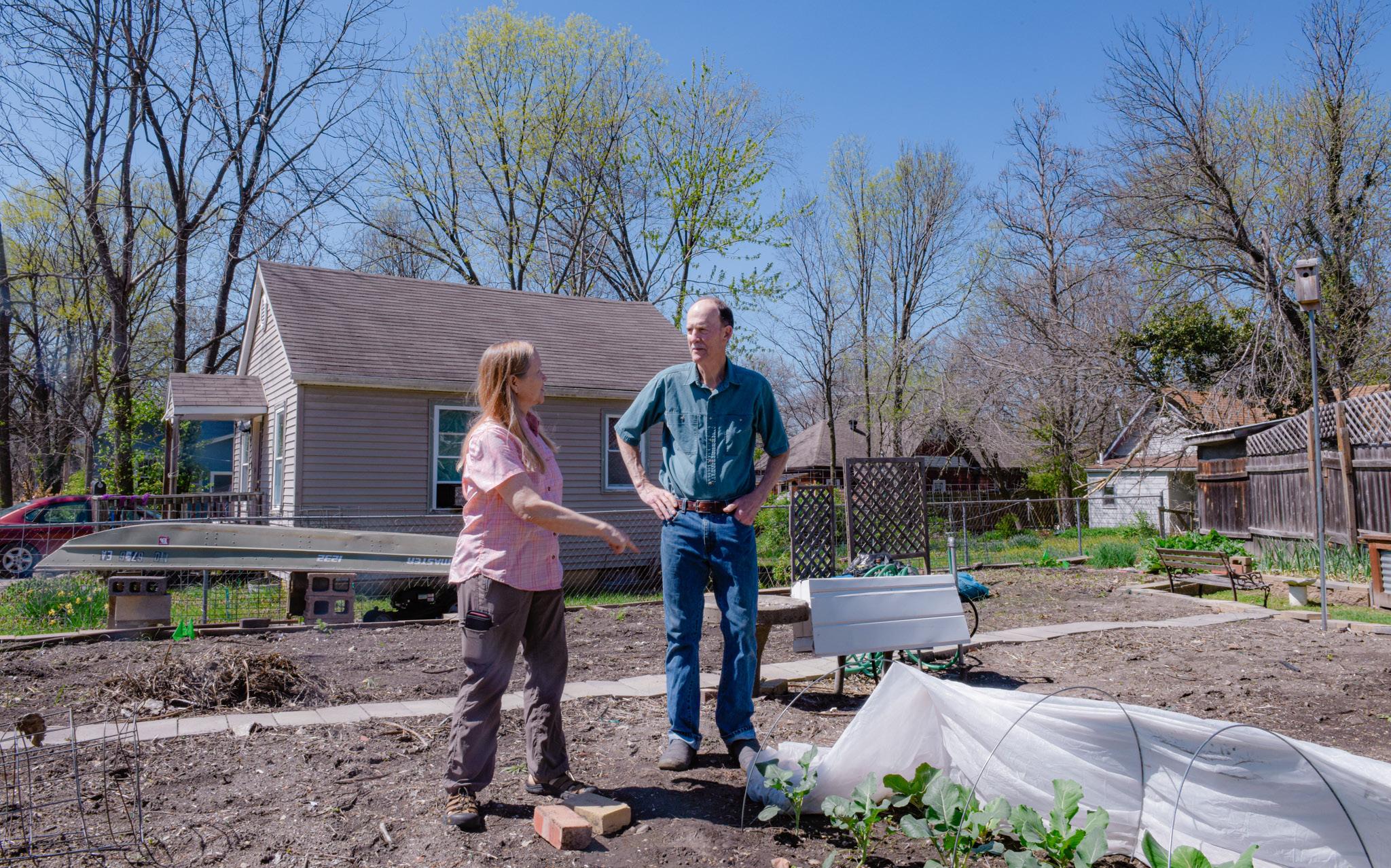
They dig gardening
KATHY DOISY STARTS EACH DAY IN HER GARDEN. SHE AND HER HUSBAND HAVE BEEN CULTIVATING FLOWERS AND PRODUCE FOR OVER 40 YEARS.
BY SAM BARRETT
Kathy Doisy, a retired University of Missouri entomologist and ecologist, starts every day by walking through her home garden, where she greets her lush landscape. The space is filled with over 30 different kinds of plants and produce that she and her husband, Matt Knowlton, have planted, tended and harvested for over 40 years.
Doisy says she has spent the majority of her life outdoors — whether it was fishing with her dad at a state park or interacting with wildlife at her grandfather’s southern Missouri farm. Growing up in the 1960s with a black-and-white TV, Doisy says she had no choice but to play outside, but she never complained.
“I spent all my time outside, and I love being outside,” Doisy says. “The only thing I don’t like about the outside is I get sunburned, so I gotta wear a cover.”
Planting roots
Doisy started her first garden in 1976 behind an old abandoned farmhouse her then-boyfriend rented. The garden was small and marked off by a rickety fence, but Doisy saw its potential and filled it with produce. She says she quickly learned gardening 101 as weeds started to pop up and plants dried out from lack of
watering. “You know, the thing that’s most great about gardening and cooking and things like that is you learn something all the time; it never gets boring,” Doisy says.
Because she spent most of her early life outdoors, Doisy says her education in entomology — the study of insects — felt natural. While receiving her master’s degree in medical and veterinary entomology and aquatics from MU, Doisy met her husband, who was obtaining his doctorate in fisheries and wildlife. Their similar interests and shared passion for nature brought them together, and they decided to plant roots in Columbia. The two moved in together in 1987 a few blocks from Stephens College and started a garden.
Doisy has had over four decades to evolve her garden into what it is today: an approximately 1,000-square-foot space.
Behind the scenes
Doisy begins her stroll by plucking dandelions from the garden bed beneath her sunroom windows. Thin black tubes with tiny holes snake through the garden beds. This is Knowlton’s automated, computerized irrigation system, which they use during absences and vacations. Otherwise, Doisy prefers to water the plants herself as it gives her more time to spend in her garden.
VOX MAGAZINE • MAY 2024
Photography by Nick Ginter
GARDENING
19
Kathy Doisy and her husband, Matt Knowlton, prepare their outdoor garden for spring.
She walks on a brick path through a small fence into her backyard, where raised garden beds hold most of her produce. There, she notes which cool-season crops are almost ready for harvest — garlic and lettuce — and records what she plans to plant next, including 12 different types of heirloom tomatoes. She planted her heirlooms the first week of March, which sit inside under a grow light, until the plants are ready to harden-off and transplant outside.
Moving back up the path and into the side garden, Doisy points out the buds on her native serviceberry. Doisy says her Missouri native plants are her favorites as they bring in more native pollinators, including leafcutter and mason bees. Knowlton built Doisy a native bee hotel made of an old shelf and bamboo sticks, which sits in their produce garden against the yards’ dividing fence. Here, the native bees can hibernate and store pollen.
Sharing the harvest
Doisy says one reason she loves to garden is because she knows where her food is coming from, and it’s pesticide free. “You keep trying things and you see what you’re good at, what you know, what’s too much work and what is better homegrown,” she says.
Doisy has found plants like kale, peas, corn, eggplants, green beans, tomatoes and peppers work for her. This is just some of the produce she and her husband harvest, can, preserve and cook with. Doisy regularly shares her harvest with her neighbors.
Doisy bends down to squash an asparagus bug off a stem and is reminded of another reason why she loves to garden. “I love everything about plants and animals,” she says. “You get to see all the interactions between nature and plants and insects, everything, that’s always interesting, but it is also a really good form of meditation.”
Doisy says when she steps into her garden, while she might be getting her hands dirty with gardening tasks, all the other worries in her life fade away.
Cultivating a legacy
After 48 years of gardening, Doisy constantly tries to spread her knowledge
Learn more about Columbia’s Community Garden Coalition at comogardens.org.

about the benefits of growing your own produce. She spent five years as president of the Community Garden Coalition — an organization dedicated to supporting community gardens and native plants.
Sarah Kendrick, a former board member of the coalition, says it was a pleasure to serve under Doisy, “because she has a passion for maintaining access to spaces in our community to grow local, healthy foods.” Kendrick was the president of the Community Garden Coalition when Doisy first joined, and they worked together closely during Doisy’s presidency. “As a prolific urban gardener herself, Kathy and her husband Matt understand the deep connections that come from growing food to nourish our bodies and to share that bounty with others,” Kendrick says.
The main gardening knowledge Doisy says she shares with others is that on top of the health benefits, growing your own food reduces your carbon footprint and is better for the environment.
“You’re not just helping yourself by growing healthy food, you’re helping nature,” Doisy says. “And in that way you’re helping everybody.”
VOX MAGAZINE •MAY 2024
Photography by Nick Ginter
20
Kathy Doisy is on the board of the Community Garden Coalition, where she has served as its garden leader liaison for six years.


LIMITED SPACE DOESN’T HAVE TO LIMIT YOUR GARDENING ASPIRATIONS.
Adhering to a plant’s water, soil and sunlight requirements is key no matter what kind of space you have. Carefully following directions for flowers, vegetables and other plants is essential for their successful growth.
PLANTS AND SPACING
First things first: what to grow. Just about any type of produce can be grown in small yards. Some plants, like herbs, may flourish indoors with a grow light. When planting, be sure to avoid crowding, as it may keep plants from getting proper water and sunlight.
POTTING
If using pots, select containers for the plants’ eventual size based on the care instructions. MU horticulturist Dhruba Dhakal recommends clay pots with drainage holes. For potted plants, Dhakal says to use potting mixes instead of garden soil. These mixes include peat moss, perlite or vermiculite, which provide a balance of moisture retention and water drainage for healthy plants and roots. Also avoid wood containers, which are susceptible to rot.
SUNLIGHT
For spaces lacking enough natural light, Kathy Doisy advises using a grow light. Grow lights are LED lamps that provide a light spectrum that’s similar to the sun. Dhakal says plants such as arugula, kale and spinach can all be continuously harvested under LED grow lights.
WATERING
Signs of overwatering include wilting or discolored leaves and stems. To prevent overwatering, gardeners like Doisy use measuring meters.
VOX MAGAZINE •MAY 2024
Photography by Nick Ginter
21
You CAN do it yourself
BY ABBY RAMIREZ
Originating in 19th century France, canning as a method of food preservation was motivated by Napoleon Bonaparte’s order to supply his troops nonperishable food during his European invasions. During that time, the canning method was heating food in corked glass containers, then sealing it with wax and wire.
While you may not being invading Europe anytime soon, you may want to preserve fruits and vegetables or make jams and jellies, salsas, pickles, relishes and condiments.
Canning methods include pressure, water bath and steam canning. Different foods require different methods. All methods start with jars being sterilized by submerging them in hot water. You use a funnel to fill them with food before covering with a lid and sealing them up.
To determine which method to use, you’ll need to understand the acidity of the food you’re preserving.
Low-acid foods like vegetables, meats and fish must be canned using a pressure canner, which is a specific type of pressure cooker for home-canning. Pressure canners reach temperatures high enough to kill clostridium botulinum, a bacteria that can survive in low-acid foods and can cause the life-threatening disease of botulism, according to the U.S. Department of Agriculture.
MU Extension recommends dial gauge or weighted gauge pressure canners found at stores like Target, Walmart and Amazon for about $80 to $120.
Most MU Extension centers, including the one located at Whitten Hall on the University of Missouri campus, will check your dial gauge pressure canner accuracy at little to no cost.
For high-acid foods like fruits, tomatoes and pickles, water bath or steam canning is the way to go.
Both processes involve a large canner pot and wire rack that holds the jars just above the base of the water or steam canner. Canning pots can be found at Walmart, Tractor Supply Co., Ace Hardware and Amazon for about $25 to $40.
These methods use lower temperatures than pressure canning, but are equally safe because the food’s natural acidity levels —or the vinegar used for pickling — doesn’t allow Clostridium botulinum to grow.
You can use any brand of canning jar, but don’t reuse product jars that cannot be resealed safely, such as mayonnaise jars. The National Center for Home Food Preservation recommends anything with a double lid, which are separated ring parts. Canning jars can be found at Walmart, Target, Ace Hardware and Amazon for about $10 to $25.
To ensure your food is safe regardless of the method you’re using, MU Extension Food Safety State Specialist Londa Nwadike says it’s important to use tested canning recipes from reputable sources. She recommends looking at the National Center for Home Food Preservation.
CANNING 101
Liz Harrison, a field specialist in nutrition and health with MU Extension, will host home food preservation courses this summer. Each will run from 5:30–7 pm and cost $25 per person. You can find the courses on extension.missouri.edu/programs.
Harvesting and storing produce May 16 – Columbia’s Agriculture Park
Freezing and dehydrating May 21 – Columbia’s Agriculture Park
Pickling June 18 – MU Family Impact Center
how to
on
Photography by Photographer Name Learn
preserve food based
this 215-year-old method.
VOX MAGAZINE •MAY 2024 22
RAISING ANIMALS
She’s not cooped up
MU STUDENT SARA LAWSON FEELS AT HOME AMONG CHICKENS.
BY GRACE BURWELL
Nestled on a winding, tree-lined road 20 minutes west of Columbia, sits the homestead where University of Missouri freshman Sara Lawson runs a mini egg empire.
Dozens of birds greet you — copper hens, black-and-white flecked roosters and ivory-colored ducks with webbed orange feet. Wind chimes cut through the crowing of roosters. Among these feathered friends is a little chicken called Reds, which Lawson says is her favorite. Reds — a mix between the Rhode Island Red and Easter Egger breeds — always appears one step behind the others as she navigates an intricate outdoor enclosure.
Lawson, a Rocheport native and first-year studio art major, wakes up at 7:30 a.m. on weekdays to tend her flock. With a poultry population of over 60 — including chickens, roosters, ducks, pigeons and one turkey — it’s no small feat, but Lawson has worked as the primary caretaker for her family’s brood since she was in fourth grade. She says taking care of chickens has become second nature.
Feeling peckish
Lawson serves her chickens a customized feed blend, which includes a variety of protein, seeds and minerals. “Sometimes they’re not getting enough minerals in their diet, and that
makes their eggs really fragile,” she says. Lawson used to make her own chicken feed, but she says it became too costly during the COVID-19 pandemic to handmix 100 pounds of flaxseed, sunflower hearts and seeds, corn and millet. Now, Lawson purchases her feed from Tractor Supply Co. or Orscheln Farm & Home. She creates a custom mix using the stores’ egg-layer feed, adding supplemental ingredients like oyster shells for more calcium.
In the henhouse
The flock spends most of the day in the outdoor enclosure. At night, the birds rest in four carefully constructed coops, which Lawson and her father, Martin, built using repurposed wood and furniture. Inside, chickens burrow in old dressers she converted into comfortable nests. Each coop serves a different purpose — one is reserved for sick chickens, one for brooding chickens and two for healthy chickens. Tucked away under a heat lamp, Lawson also houses 15 chicks. She says she plans to get more over the summer.
She collects around 14 dozen eggs a week and gives the majority to friends and family. She also loans eggs to Mill Creek Elementary for hatching in classrooms. Alongside her

VOX MAGAZINE • MAY 2024
23
MU student Sarah Lawson feeds her chickens early each morning. They produce 14 dozen eggs a week that she gives away.
Photography by Jamie Maron
WHERE DO I BUY CHICKENS?
Sara Lawson recommends Cackle Hatchery in Lebanon. “I’ve been to the facilities myself, and it’s very nice,” she says. “They’re a very good company.”
In addition, former MU Extension poultry associate Jesse Lyons recommends Estes Hatchery in Springfield. You can also order online from hatcheries in other states that ship chicks, such as Murray McMurray Hatchery and Hoover’s Hatchery in Iowa, Lyons says.
WHAT DOES THE CITY OF COLUMBIA ALLOW?
Columbia residents are allowed to have, at most, six hens — but no roosters. According to the city’s chicken ordinance, chickens must be kept in an enclosure or fenced area at all times, and noise and odor must be contained to one’s property. Hopeful poultry owners can review Columbia’s full list of regulations in its online code of ordinances.
WHAT BREEDS ARE BEST FOR BEGINNERS?
Lawson recommends the Dominique chicken for the breeds’ hardiness and egg production. Lyons says breeds like Rhode Island Red and Barred Plymouth Rock’s are ideal egg layers. “The heavier breeds such as the red and brown egg layers make very good small flock chickens,” Lyons says. Breeds like Easter Eggers that produce colorful eggs are not as hardy and are more for show, Lawson says. “A limited number of those (makes) a little variety in the egg carton for interest and a little excitement,” Lyons says.
WHAT KIND OF CHICKEN FEED IS BEST?
The brand Lawson uses most often is Nutrena NatureWise chicken feed. She recommends the brand because it offers a variety of feed for chicks, egg layers and other poultry.
CAN I TRAIN MY CHICKENS?
Lawson says 100%. She has conditioned her chickens to return to their enclosure at sunset. “They’re very food motivated,” Lawson says.
MU Extension has more information on raising chickens at extension. missouri.edu/topics/poultry.

grandmother, Edna, Lawson customizes each egg with a hand-carved stamp that reads “Sara’s Farm.” Lawson gives out the eggs for free, but says many offer support through cash donations or by giving her chickens they no longer want. She welcomes new additions.
Beyond birds
From her family’s homestead on the bluffs of the Missouri River, Lawson drives to MU’s campus for class every weekday. Outside of raising chickens, Lawson plays the cello — she’s a music minor — and hopes to work in art conservation in the future. She says she’ll likely stick around to help her family with the homestead before going to graduate school. “I’m training my brother to take on the mantle,” she says. Beyond poultry, Lawson’s family grows tomatoes, okra, garlic and green beans for canning salsas and sauces. Apple, cherry, peach, pear and plum trees line the chicken enclosure, and the family uses the fruits to make jam.
Supporting local
The different chickens all have personalities, Lawson says. To her, the birds are a source of enjoyment and fulfillment.
She says it’s important to support local businesses when it comes to purchasing chicken eggs and meat. “It’s going to be a little bit more expensive, but that just comes with the territory,” she says. “It’s good to be supporting your local businesses or your local farms — that way they can continue to produce the meat for you and the community.”
A girls’ best friend
Lawson says she enjoys helping others see the personality of chickens. They’re silly, curious and will eat anything and everything. Lawson’s flock gives her something to care for, she says. “I know some people like to characterize chickens as dumb animals, or they don’t really have a lot going on or they’re just a bunch of mess or a food source,” Lawson says. “I would like people to understand they can also be a source of enjoyment or fulfillment.”
VOX MAGAZINE •MAY 2024
Photography by Jamie Maron
24

MAKING
Levi, 2 (from left), and Adaya, 13, work alongside their parents Sarah and Zach at their home’s workshop.
Niobrara Naturals candles (below) are soy based and contain natural essential oils.

They’re really milking it
SARAH AND ZACH MUNGER RUN THEIR FAMILY GOAT MILK SKINCARE BUSINESS WITH THEIR KIDS — AND THEIR FIVE CHILDREN.
BY OLIVIA MAHL
When Sarah Munger developed eczema over a decade ago, she tried every topical solution her dermatologist recommended, but nothing worked. Being the crafty, self-sufficient person she is, Munger decided to make her own antidote using one key ingredient — goat milk.
“I had read that goat milk soap was really good for eczema, and I had dairy goats,” Munger says. “So I thought, ‘I’ll try making soap. It sounds fun.’”
After the soap worked to clear her skin, Munger continued to make it and opened an all-natural skincare business, Niobrara Naturals, in 2013. She ran the business alone until she married her husband, Zach Munger, in 2020. Since joining forces, they’ve created over 10 skincare and household
products while running the business from their homestead in Higbee.
Living in dreamland
Growing up with parents who dabbled in homesteading, self-reliance is second nature for Munger. When she and her siblings were children, they helped their parents care for their garden and animals, including the dairy goats that helped her create soap for the first time.
Before starting Niobrara Naturals, Munger longed to live the life she has now. “It was always my dream to be able to do that if I ever married and had kids and to pass it on to them,” Munger says.
That dream came true when she married Zach, who had four kids. Only a year ago they welcomed their fifth. After growing up working on ranches in Wyoming,
he, too, shared the same desire to live off the land and have a family business.
“I don’t know if he ever dreamed of having goats,” Munger says. “But he married me.”
Now, the couple cares for their five children, who help around the homestead like Munger once did. “I absolutely love working with my family and having them right there with me every day,” Zach Munger says.
It comes naturally
Two years ago, the Mungers built the Niobrara Naturals workshop on their land as a hub for their business. As they work, Zach Munger does most of the product manufacturing while Sarah Munger handles the finishing touches, which takes more time.
VOX MAGAZINE • MAY 2024
Photography by Ellie Frysztak
25
Find the Mungers’ products at niobraranaturals.com
or at the Columbia Farmers Market.
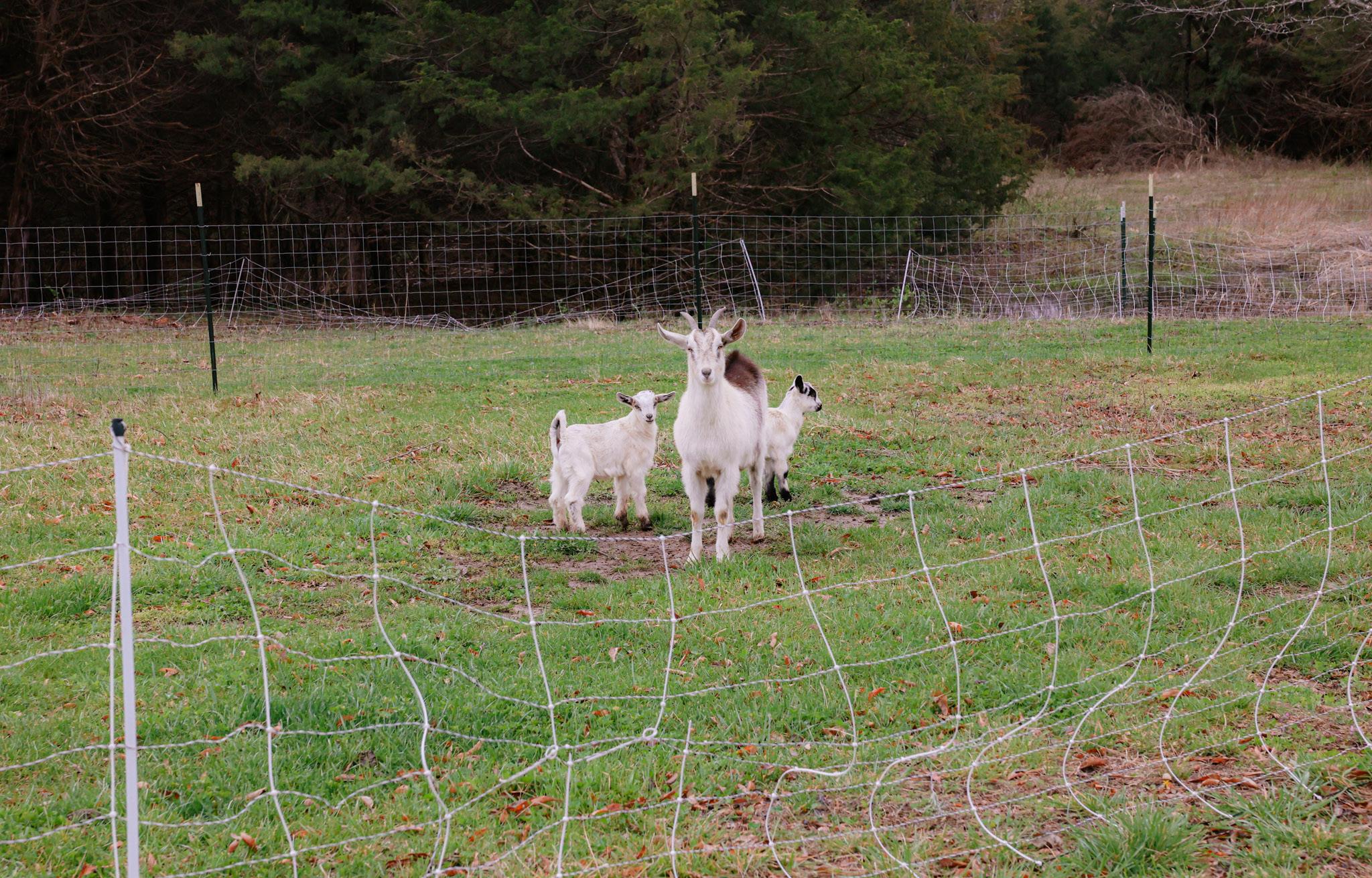
“It’s been amazing. Like a dream come true.”
SARAH MUNGER
NIOBRARA NATURALS FOUNDER
Their kids occasionally join them while they work, but most of them prefer to sell the finished products at the Columbia Farmers Market, where Munger began selling in 2015.
All of their items, including soaps, candles, insect repellent and deodorant, have unique formulas. The Mungers test each item before producing a product in bulk. With a focus on keeping things simple, the ingredient lists are short.
The soap recipe that started Niobrara Naturals begins with a mixed base of olive, coconut and palm oils, followed by their key ingredient, goat milk. That concoction is then topped off with essential oils and additives like natural colorant.
Farm-fresh future
The Mungers are always working to improve their products while simultaneously looking to become more self-sustainable.
“As we have time and resources, we plan to add berry
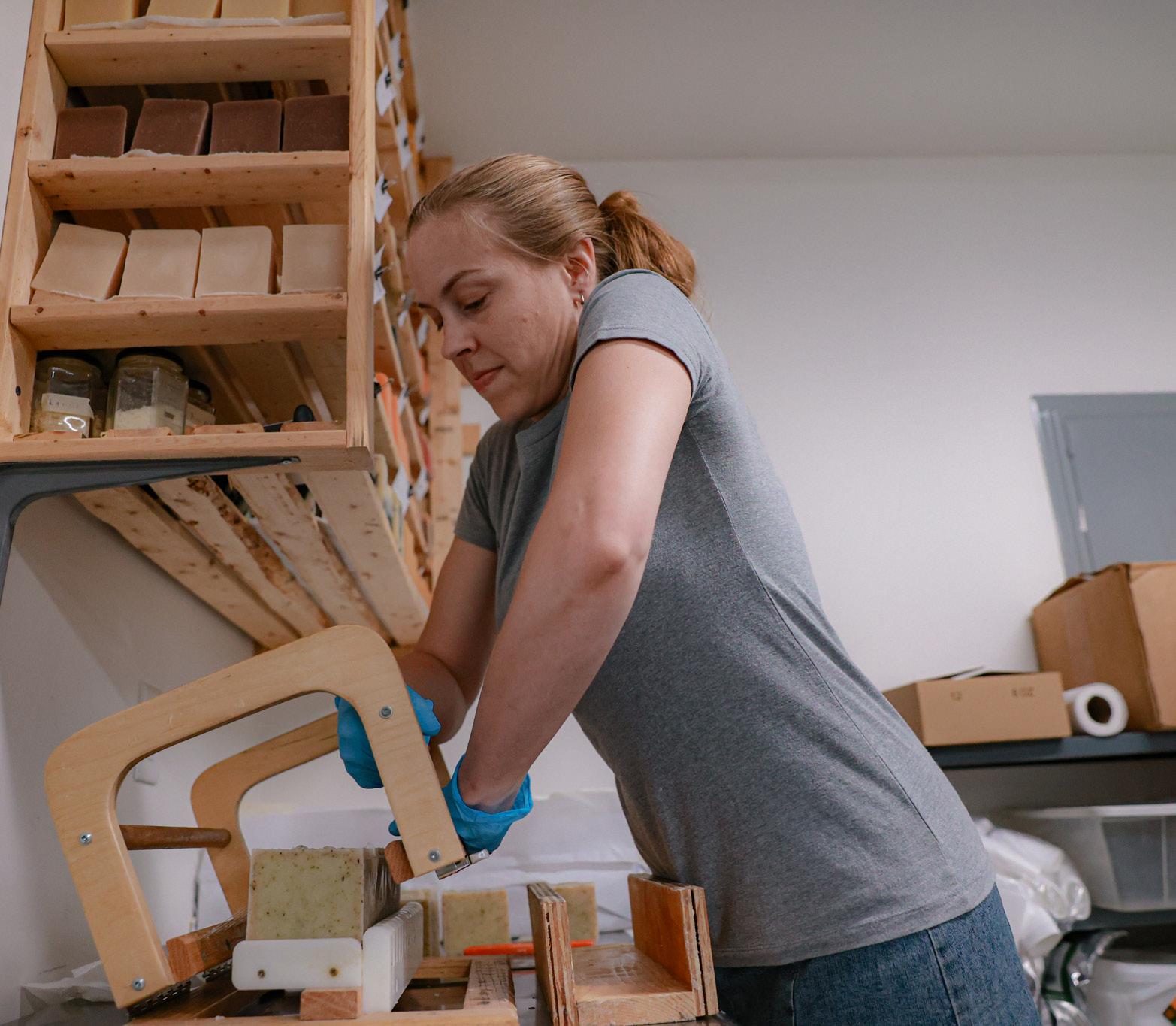
bushes, a greenhouse, more clear grazing ground for our animals, and any excess milk from our goats will be for our family use, including making some cheeses,” Munger says.
They are hoping to expand to use their honey in their items, too. The Mungers harvested 60 pounds of honey from their honeybees last season and are experimenting with ways to use it in their sugar scrubs. They use the eggs that their hens supply, too, sharing them with their extended family.
Although Munger makes all of their bread and grinds her own flour, she still buys their wheat from Amish farmers in Higbee.
Their land also provides them with meat. Zach Munger often hunts deer on the land, and they fish in their lake as a family.
This year, Sarah Munger says they are expanding their vegetable garden, which will allow them to be more self-sufficient by providing more produce to can and freeze.
“It’s been amazing. Like a dream come true,” Sarah says.
VOX MAGAZINE •MAY 2024
Photography by Ellie Frysztak
26
The Mungers’ dairy goat named Lily recently gave birth to two kids.


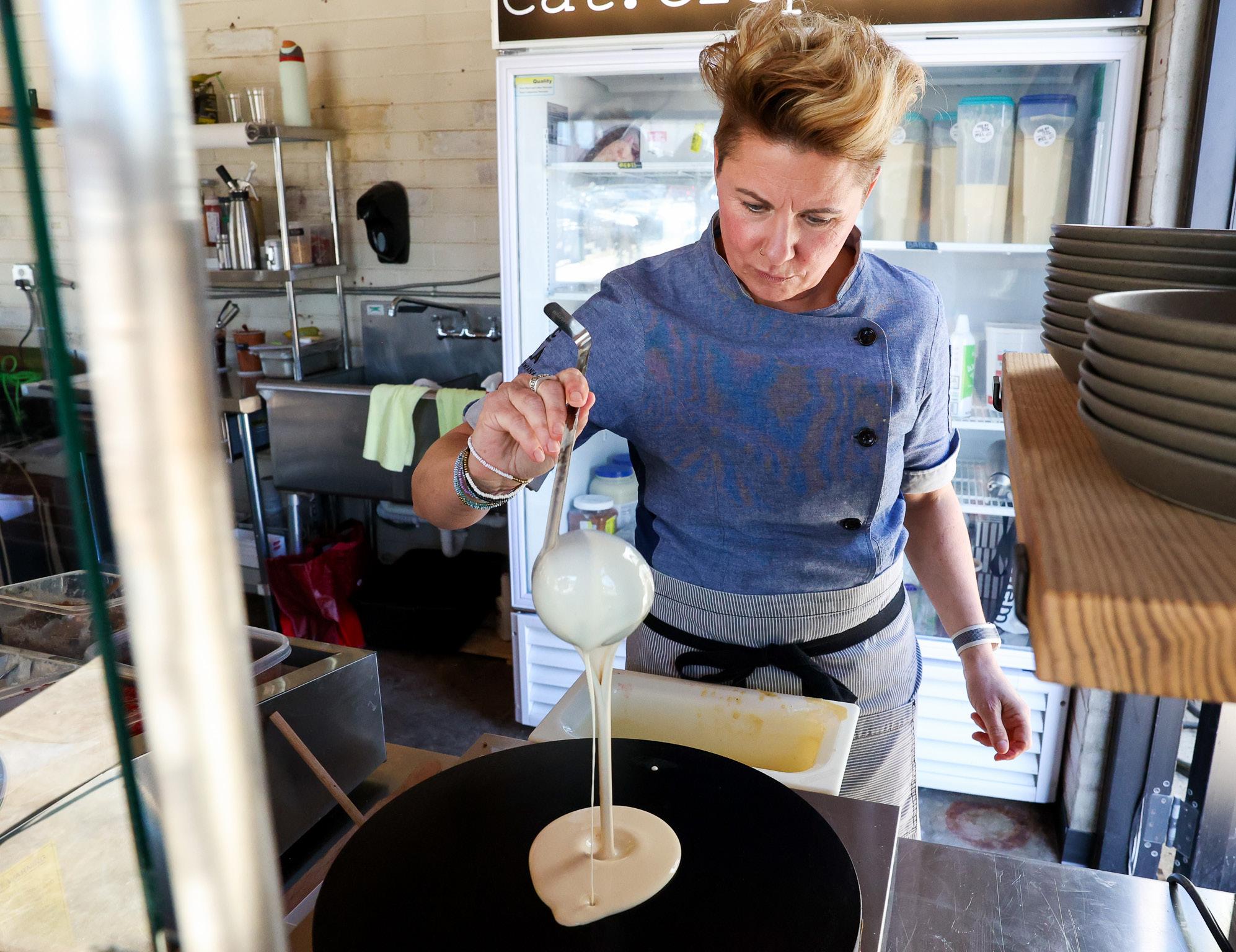
Batter up!
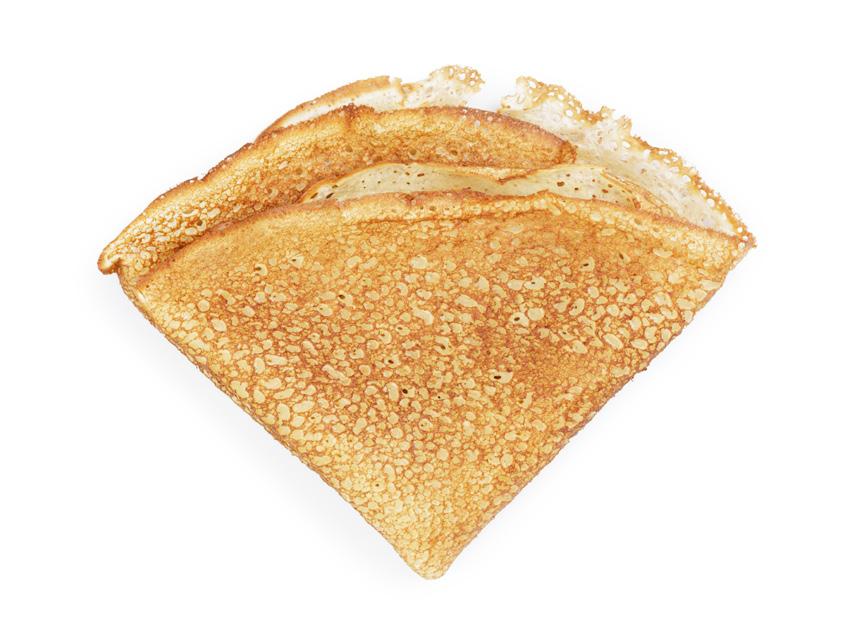
Eat.crepe.love. and Acola Coffee now share a space so you can pick up a crepe with your coffee.
BY OLIVIA MAILLET
Walking into Acola Coffee Company, you smell the aroma of coffee mixed with the sweet and savory scents of fresh crepes. This delicious combination is brand new — Acola and eat.crepe.love. joined forces under the same roof in January.
“We are still working on figuring out the branding,” says Nick McKague, who co-owns Acola with his wife, Autum. “We want both names to exist.”
Carla Kessell and Tiff Walker started eat.crepe.love. in 2016 as a creperie cart in Jefferson City. The cart was another source of income for them while they
Carla Kessell pours crepe batter onto a hot griddle. Kessell started eat.crepe. love. as a creperie cart in Jefferson City. It’s now located at Acola Coffee Company, 300 N. Tenth St and it has an ever-changing menu of sweet and savory options.
raised three teenagers. Kessell says she was inspired by the Belgian crepes she would make with her uncle, when he visited from Belgium. Kessell liked the idea of being able to change the menu frequently to try new combinations that are both sweet and savory.
A grand(e) backstory
Before the merger, these four business owners interacted often. They crossed paths at events, which eat.crepe.love. would often cater. In Kessell’s previous job at the wholesale restaurant and food distributor Sysco, she visited Acola to
27 VOX MAGAZINE • MAY 2024
CHEAP
P. 29
Photography by Halle Paulus and courtesy of Adobe Stock
TREAT, EXTRA SWEET

help with food and drink ideas. She would also work remotely from the shop, and knew the owners of Three Story Coffee before it changed ownership and became Acola in April 2022. The joining of the two businesses seemed natural.
Whether ordering drinks or crepes, customers pay at the same register. Walking through the shop, a former location for Busch’s Flourist, now houses the creperie. A next step for Acola and eat.crepe.love. is to have a cooler for grab-and-go floral arrangements from Busch’s Florist, which is located in Jefferson City, at their location, Kessell says.
Since the soft launch in February, Kessell has been tweaking the menu to cater to the Columbia community. The One Night in Bangkok, which had Thai marinated shrimp and cilantro jalapeno slaw, was a bestseller when eat. crepe.love. was mobile in Jefferson City. A popular crepe at Acola is the Super Nova, a savory crepe combining smoked salmon and hashbrowns. She says it takes trial and error to find what customers like, so the menu changes seasonally.
Flipping good
Having a permanent location for eat. crepe.love. has been a good adjustment for Kessell. Instead of carting all the
supplies in, she can run back to Acola’s kitchen to grab ingredients and utensils. Kessell has full confidence in her staff and understands that making crepes is a learning curve.
“Change is sometimes hard but good,” Nick McKague says. “Carla has embraced putting the right people in the right place with what their skill set is. Embracing the old, putting in the new, meshing it all together.”
Melissa Rogge, a crepe creator manager, spends her shift prepping batter and ingredients, cleaning griddles and taking orders.
“We split orders between the sweet line and savory line,” Rogge says. “You have to make sure the crepe is ready and add in all the fixings, and basically making each crepe is like making artwork.”
Acola and eat.crepe.love. have a merger built on friendship, respect, a love for serving the Columbia community and treating people with kindness.
“The goal is no matter how busy or slow it is, whatever goes out the door represents you,” Nick McKague says.

28 EAT + DRINK RESTAURANTS VOX MAGAZINE •MAY 2024
Photography by Halle Paulus
Grace Andrews garnishes a crepe. Eat.crepe.love. offers crepe options like Bacon Jalapeno Popper and Salted Caramel.
Get yourself a treat
Sometimes you just need a sweet snack. And after making it through a long day, you’ve earned it. Here are six places to pick up little goodies — for $6 or less.
BY KEARA CONNOLLY

If you’ve been on TikTok in the past several months, chances are you’re familiar with “little treat” culture — buying something small and sweet as a sort of self-reward. After seeing users talk about getting themselves a sugary confection, you might want one yourself.
Lucky for you, Columbia provides countless choices to satisfy cravings for a small, sweet something. Whether that’s the perfect coffee or a hand-crafted pastry, we’ve got you covered. Here are six places you can get yourself a treat for $6 or less.
Homemade Pop Tart
Shop: Beet Box
Address: 602 Fay St.
Cost: $4.50
Beet Box’s homemade Pop Tarts come in different flavors depending on the
day you come in. Some recent flavors include honey blueberry, black cherry and raspberry apple, and each variety is made from scratch. Alongside items that are available daily, Beet Box’s rotating menu features a cast of baked goods that changes regularly.

The Wedding Cake cupcake is an almond cake with almond buttercream, making it a light, sweet option to celebrate the end of the day. There are 16 cupcake flavors at Columbia’s Smallcakes every day, and the location has some unique varieties. The Wedding Cake cupcake is one of the most popular choices, but its other flavors make great treats, too.
1. Bobaholic’s sparkling sodas come in four primary flavors: strawberry, green apple, peach and passion fruit. Its tea flavors can be made into sparkling sodas as well.
2. Smallcakes’ Wedding Cake cupcakes are an almond-flavored delight.
3. Beet Box’s homemade Pop Tarts come in an array of rotating flavors.

Sparkling soda Shop: Bobaholic Address: 212 E. Green Meadows Road, Suite 7A Cost: $5.50
At Bobaholic, there are many sweet treats to choose from. One of the store’s most popular items is the sparkling soda, a fresh fruit-infused drink that includes fresh lime, fruit flavor syrup and carbonated soda. You can choose between strawberry, passion fruit, green apple or peach.
29
EAT & DRINK DESSERTS VOX MAGAZINE • MAY 2024
Photography by Rilee Malloy and photography courtesy of Adelle McAlister and Beet Box
Wedding Cake cupcake Shop: Smallcakes Cupcakery Address: 2609 E. Broadway, Suite 218 Cost: $4.50
2
1
3
Macarons
Shop: U Knead Sweets
Address: 808 Cherry St.
Cost: $2.35
U Knead Sweets’ macarons come in a wide variety of flavors. From chocolate to lavender to Earl Grey, there’s something for everyone. These brightly colored French treats have a mix of textures. The crispy outer shells of the almond meringue cookies come together with the flavorful, soft filling in the middle. U Knead Sweets carries out the delicate process of making macarons in its own kitchen, so every macaron you get is handcrafted in-house.
Strawberry Mojito Agua Tropical
Shop: La Calle 8 Cafe
Address: 214 S. Eighth St.
Cost: $5
La Calle 8 has several different flavors for its Aguas Tropicales, and its most recent addition is the strawberry mojito. This refreshing fruit-flavored drink is a non-alcoholic version of the traditional mojito with strawberry flavoring. Owner

1. Shortwave Coffee’s latte can be made sweeter with flavored syrups like vanilla or lavender.
2. U Knead Sweets’ macarons come in a rainbow of flavors, from strawberry or lemon to Earl Grey or dulce de leche.
3. La Calle 8’s Strawberry Mojito Agua Tropical is one of its newest menu items.



Latte
Shop: Shortwave Coffee
Address: 29 S. Ninth St.
Price: $5, $5.75 with flavor syrups
Shortwave Coffee focuses on balancing its drinks and creating the right flavor. The store’s lattes are made with natural ingredients. For an extra charge, you can add one of the flavored syrups: vanilla, cardamom, mocha, caramel or lavender. Even with the flavored syrup, Shortwave aims to make sure you can still taste the coffee.
30
EAT & DRINK DESSERTS VOX MAGAZINE •MAY 2024
Photography courtesy of Shortwave Coffee, Rafael Bobea and U Knead Sweets
Rafael Bobea says the drink makes for a unique treat.
3 1 2



Ask before you speak
Knowing what language and labels to use surrounding autism can be difficult. It doesn’t have to be.
BY MADISON ARENAZ
What you say matters. This includes the words you use when referring to people in the autistic community. The growing interest in shows like Love on the Spectrum raises questions about language to use for a mass audience.
Some autism advocates say that the popular TV show, which focuses on the love lives of autistic people, infantilizes participants or that it isn’t representative. This discourse around Love on the Spectrum is just one example of larger ques-
tions on what words to use when referring to the autistic community. What phrases are considered outdated? How do you navigate such a complex topic without offending anyone? Even within the autistic community, there isn’t always a clear answer.
Person-first or identity-first?
Take, for instance, the question of how to refer to an autistic person. Some people prefer person-first language,
Both Chris Faughn and his daughter Charlotte Faughn, 12, have been diagnosed with autism.“I just wish there was more understanding of the community of autism, but it’s been getting better over the years,” Chris Faughn says.
such as “a person with autism.” Others prefer identity-first: “an autistic person.” The reasoning behind preferences can vary. Amber Cheek, director of accessibility and ADA coordinator at the University of Missouri, says answers tend to be generational.
“When I am talking to another person with a disability and I’m describing my disability, I always say ‘I am an amputee,’ ” Cheek says. “I use identity-based language.”
31 VOX MAGAZINE • MAY 2024
IT’S A WONDER WHAT WASTE CAN DO P. 33
Photography by Ashlee Klotzbuecher
Autism advocates now typically prefer identity-first language. Supporters say it emphasizes that autism is inseparable from the person diagnosed because it’s often an integral part of their identity. A survey done by autistic advocate, author and public speaker Chris Bonnello found that of the 11,000 people surveyed, over half of autistic respondents only use the term “autistic person.”
Lydia Brown, a national autism advocate agrees. On the “Autistic Self Advocacy Network” website, she writes: “It is impossible to affirm the value and worth of an Autistic person without recognizing his or her identity as an Autistic person. Referring to me as ‘a person with autism,’ or ‘an individual with ASD’ demeans who I am because it denies who I am.”
However, Bonnello’s survey also found that 11% of autistic respondents use “a person with autism.” Those who prefer person-first language often say that it emphasizes personhood.
Zackary Sample, a 20-year-old with autism, is among those who prefer person-first language. “A lot of the time, people use the word autistic as an insult to try and get a rise out of people,” Zackary Sample says.
The debate speaks more broadly to the diversity of experience within the autistic community and the universal need for more people to seek out education.
It’s important to “recognize each story is going to be different,” says Jacque Sample, an occupational therapist and mother of Zackary Sample.
Outdated terms
The term autism spectrum disorder, — or ASD — is also controversial. Some say the term is over-medicalized, furthering the false idea that autism is a disease to be cured.
“It’s a disorder relative to how society is set up, but that labeling feels hurtful and dismissive,” says Kimberly Threatt, the parent of a 3-year-old diagnosed with autism.
Cheek echos many others when she says, “The diagnosis term ASD just doesn’t encapsulate that cultural experience.”
Autism is a common alternative to the phrase autism spectrum disorder. There’s a movement toward seeing autism as a neu-
LOCAL RESOURCES
Columbia has many organizations that help autistic people seeking guidance in becoming more independent and social.
Easter Seals Midwest Autism Services easterseals.com/ midwest/ 573-874-3777
Impact Support Services impactmissouri.org 573-474-9446
Thompson Center for Autism and Neurodevelopment thompsoncenter. missouri.edu 573-884-6052
Woodhaven woodhaventeam. org 573-875-6181
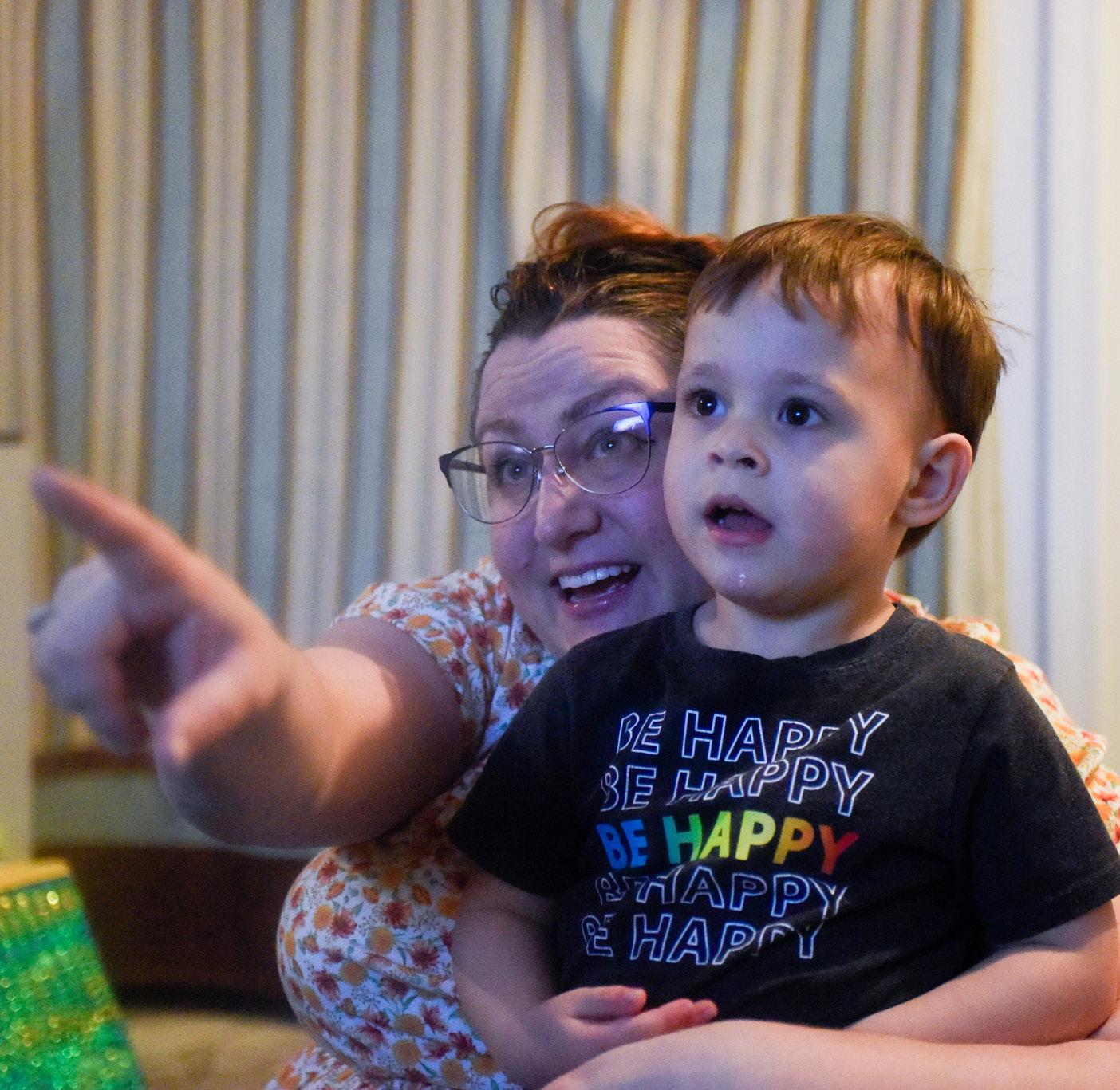
rodevelopmental difference instead of a disorder, and many prefer this terminology.
Other terms considered outdated and potentially offensive include the labels high-functioning and low-functioning. These labels can be misleading because they are often based on outward attributes, such as the ability to verbally communicate. Additionally, for those who are deemed low-functioning, Zackary Sample says it implies the question: “Are you a low-functioning human being?”
The fifth and most recent edition of The Diagnostic and Statistical Manual of Mental Disorders offers a different way of referring to autism by breaking it down to three levels of support needs. From “requires support” to “requires very substantial support.” These levels are fluid, meaning people might have different behaviors that require varying levels of support.
Threatt says support needs differ situationally, making high or low labels imprecise. Someone might call her son high-functioning at a particular time because he’s “in an environment he could thrive in,” she says.
Some labels can help
Chris Faughn, a Columbia resident who sought and received an autism diagnosis in adulthood after both of his children were diagnosed, says he feels there are some practical benefits to using functioning labels. When seeking out resources and support for his son, he says the labels, “helped people who weren’t familiar with the spectrum understand kind of what they were getting into.”
Some people in the autistic community have suggested that viable alternative phrases could be high-support needs and low-support needs, as they still identify who may need more resources while removing the stigma that autistic people don’t function as they should.
To find out what words to say, talk to people and see what terms they’re comfortable with. Keep an open mind and be ready to adjust what you’re used to saying when speaking to someone who has different preferences. The answers to many of these questions about wording aren’t clear, but they can be found — if you’re willing to look.
32 CITY LIFE COMMUNITY VOX MAGAZINE •MAY 2024
Photography by Catie Cobble
Kimberly Threatt and her son Jamie Threatt watch Thomas the Tank Engine. Jamie also loves to watch Minions movies.



Scraps to soil
Local gardeners are turning their food trash into food for their yards. Learn how to make the most of compost.
BY MAYA DAWSON
Kathryn Sharp Sapp admits
she’s a little grossed out by the worms in her home composter, but she appreciates the work of the “busy little dudes.” Sapp places fruit and vegetable scraps into one side of her barrel composter, and after three months, microorganisms break down the scraps into rich soil Sapp can use to grow flowers.
Of the 66.2 million tons of food waste generated in the U.S. annually, only 5% is composted, according to the Environmental Protection Agency. To help address this, last year, the University of Missouri began transporting dining hall scraps, compostable utensils, cups

It takes three months for the worms in Kathryn Sharp Sapp’s compost bin to break down scraps and yard waste into rich soil.
GET DOWN AND DIRTY
and containers to a commercial composting facility, says MU Campus Dining Services Director Don Jackson. The City of Columbia also offers composting workshops to encourage the practice.
While such initiatives take steps toward reducing food waste, residents like Sapp have long been dedicated to the practice.
Composting at home
When food waste enters landfills, it’s sealed underground without exposure to oxygen. Composting exposes waste to oxygen, which allows it to break down. This also reduces the decomposing waste’s methane emissions. The result
is a nutrient-rich material that can be used for gardening.
“You’re throwing away black gold if you’re a gardener,” says volunteer compost instructor Debbie Lacy-Anderson. “You’re putting things into the landfill that don’t need to go there.”
Lacy-Anderson emphasizes that composting is science, but not rocket science. A compost pile should be onethird greens like food scraps or grass clippings and two-thirds browns like dead leaves or coffee grounds. Dairy and meat products shouldn’t be added to typical composting bins. The pile must be turned regularly to expose the materials to air.
Space for your waste
Lacy-Anderson teaches free workshops for the city that focus on finding composting solutions for a variety of spaces. Those with large yards might prefer to make a big pile of compost while others with smaller spaces or strict neighborhood regulations need a more discreet setup, whether it be your backyard or kitchen.
“We can so easily take care of food waste right in our own homes,” says Jody Cook, the director of compost education for Columbia. Composting can also be done within plastic storage containers that can be kept inside.
If you don’t garden
Learn how to compost at one of these one-hour city events. For information, contact Jody Cook at jody. cook@CoMo.gov or 573-874-6271
Capen Park
6 p.m. May 7 and 11 a.m. June 8
Columbia Farmers Market
9:30 a.m. and 11 a.m. May 11
Britt/Hall
Community Garden
Lacy-Anderson says there’s a place for composting in your life, even if you don’t have a garden. She recommends giving your composted soil to a friend or using it in flowerpots.
If you have yard waste, but don’t want to compost at home, Columbia has two residential yard waste drop-off centers. Leaves, grass clippings, brush and branches can be mulched by the city and used in its bioreactor landfill, which accelerates the decomposition and stabilization of waste. Methane is collected from the landfill to generate electricity at Columbia’s bioenergy plant.
For residents looking to make a positive impact on the environment, home composting is a viable option.

6 p.m. Aug. 13
“I think any time you can stop that cycle of waste, it’s good for the earth, good for our gardens,” Lacy-Anderson says.
33
CITY LIFE GARDENING VOX MAGAZINE • MAY 2024
Photography by Jj Measer and illustrations by Valerie Tiscareno
Her road to recovery
Anita Dye once used the services at Room at the Inn. Now, she works there.
BY OLIVIA MAHL
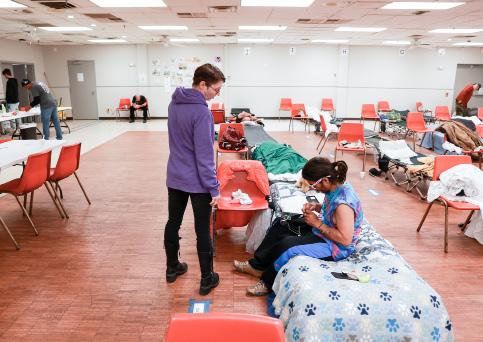
At 4:45 a.m., Anita Dye begins setting up breakfast at Room at the Inn. She starts by brewing the coffee, getting cereal and granola bars ready and preparing oatmeal. Next on her to-do list is to get fruit out and start making turkey and cheese and ham and cheese sandwiches for the night shift.
When the shelter’s guests wake up, she’ll serve breakfast.
Dye became an employee at Room at the Inn in October 2023. Since then, it has become a year-round shelter instead of operating seasonally. But Dye’s relationship with it didn’t start there. Dye used the shelter while experiencing homelessness and working toward sobriety.
afraid of being rejected, but I knew it was a chance I had to take.”
According to American Addiction Centers, which specializes in addiction treatment nationwide, it can be a struggle to get a job and find a place to live while trying to stay sober. For many, getting out of homelessness means navigating complicated systems with little stability.

After using a number of services, including shelters, housing vouchers, sober living and 12-step sobriety programs, Dye is now sober, housed and employed.
Journey to sobriety
“It was scary,” Dye says in reference to when she first applied for the job. “I was afraid of being turned down. I was
In 2014, Dye began using drugs and lost her Cape Girardeau apartment.
After a few years of being unhoused, Dye and her then-partner decided they
needed to get away from their drugfilled environment. In 2018, she landed in Columbia.
Their initial plan was to go to Kansas City. But while traveling by bus, they decided to get off in Columbia at the Midway Travel Plaza bus station.“I will never forget that day,” Dye says.
The station is a 10-minute drive from downtown, but would’ve been a long walk for Dye and her partner. So, the two hitchhiked until they stumbled upon Turning Point, a day center that provides services for unhoused people.
For the first couple of weeks in Columbia, they were sober. Eventually, they began using drugs again and sleeping in the woods.
“A lot of times (with) unhoused people, their path forward isn’t linear,” says John Trapp, executive director of Room at the Inn. “It’s more like a step; they’ll take a step and then it might be a while before they take another step, or they might even backslide.”
Trapp has seen Dye develop strength and set boundaries as he has watched her journey to sobriety.
Dye wrote about this journey as part of a Feb. 29 Celebrate Recovery meeting at TrueLife Apostolic. “Meth is not my name nor is it heroin, PCP, LSD, marijuana or acid,” Dye writes.
Anita Dye talks with guest Nelson Elias at Room at the Inn.
Elias has known Dye since Elias became unhoused. “She’s come a long way,” Elias says.
“My name is Anita, and I am not defined by the drugs I used. No longer does it rule my life. I am no longer pinned to a life of feeling like I am a nobody with no purpose. The truth of the matter is, I will always be an addict. But I have control of my addiction, my addiction doesn’t have control of me. But it will always be a day-to-day struggle, and with God on my side, I will win. I will be me.
My name is Anita, and I am somebody because God says I am.”
Dye attends Celebrate Recovery weekly as well as recovery meetings at Destiny Pointe Church on Tuesdays. These meetings are part of a 12-step recovery program centered around the Christian faith.
She is now 18 months sober.
Finding a path forward
The ups and downs didn’t stop once Dye got sober. She has faced challenges
34
VOX MAGAZINE •MAY 2024 CITY LIFE COMMUNITY
Photography by Cara Penquite
finding a job and housing, as well as navigating her mental health. Typically, Room at the Inn only hires former guests who haven’t used the service for two years. So when Dye asked for a job, Trapp had to get special permission.
“I saw that she was doing well so I went and got special permission from my board of directors,” Trapp says. “I like to hire folks that maybe other people might not. People that I see might need a chance. I feel like if we’re not gonna give them a chance who’s going to.”
Managing Director Darren Morton has a similar outlook. Right now, he has five formerly unhoused employees working for him.
“It starts with the small things,” Morton says. “We try to bring from the community, hire from the community.”
Once Dye decided to get sober, she was living at Room at the Inn and then went to Harbor House, another local shelter for the unhoused community. Then she went to Fresh Start, a sober living program. That’s where she got a housing voucher in January 2023 via Burrell Behavioral Health to get her own apartment, but it would take almost six months for her to find a home.
The housing vouchers are part of a government assistance program that helps people pay rent. Recipients of
vouchers have only 60 days to find an apartment, according to the Columbia Housing Authority. Like others who use vouchers, Dyes’ time ran out several times.
“We’re still having problems with people taking (the vouchers),” Dye says. “Landlords don’t want to take them, even though it’s a guaranteed income.”
After a few stressful months and almost losing her voucher again, Dye secured her apartment with the help of landlord James Bayless before her voucher expired. She moved in on June 1, 2023.
When Dye entered her new apartment, she sat down on the living room floor and stared at the space around her. As she sat there, an overwhelming feeling settled in, and all she could think was, “Is this mine, is this real?” She tapped the floors and hit the walls to make sure.
The first night she stayed at the apartment, she slept on the bedroom floor with a couple of blankets. The next day, a Fresh Start employee came and helped her move her things from the shelter to her new home.
“I remember just taking everything out of my bags and just throwing it all over the place, saying, ‘Yes I can do this, this is mine.’ ” Dye says. “My clothes, I threw them all over the living room and cried.”
A SAFE HAVEN
Starting in fall 2023, Room at the Inn is open yearround at 1509 Ashley St. There are 83 available cots per night. For information, contact info@ roomattheinn como.org, 573825-6029 or visit the shelter in person after 5:30 p.m. To volunteer, visit roomattheinncomo. org/volunteer
Giving back
Dye still meets with Morton and gives back to the unhoused community that she was once a part of.
Over the past six years, Dye has made over 500 scarves from donated yarn. She gives them out to the unhoused community and others in need. Currently, she’s working on orders from local food banks for 250 scarves, which they plan to gift next winter.
Dye supports the community as much as she can, but she is careful not to return to her old habits and risk her sobriety .
“I try to help when I can,” Dye says. “But I have to be careful how I help, so I don’t hurt myself. They’re still my friends. I’m not going to abandon them just because I have a place. They’re still people, they’re still somebody.”

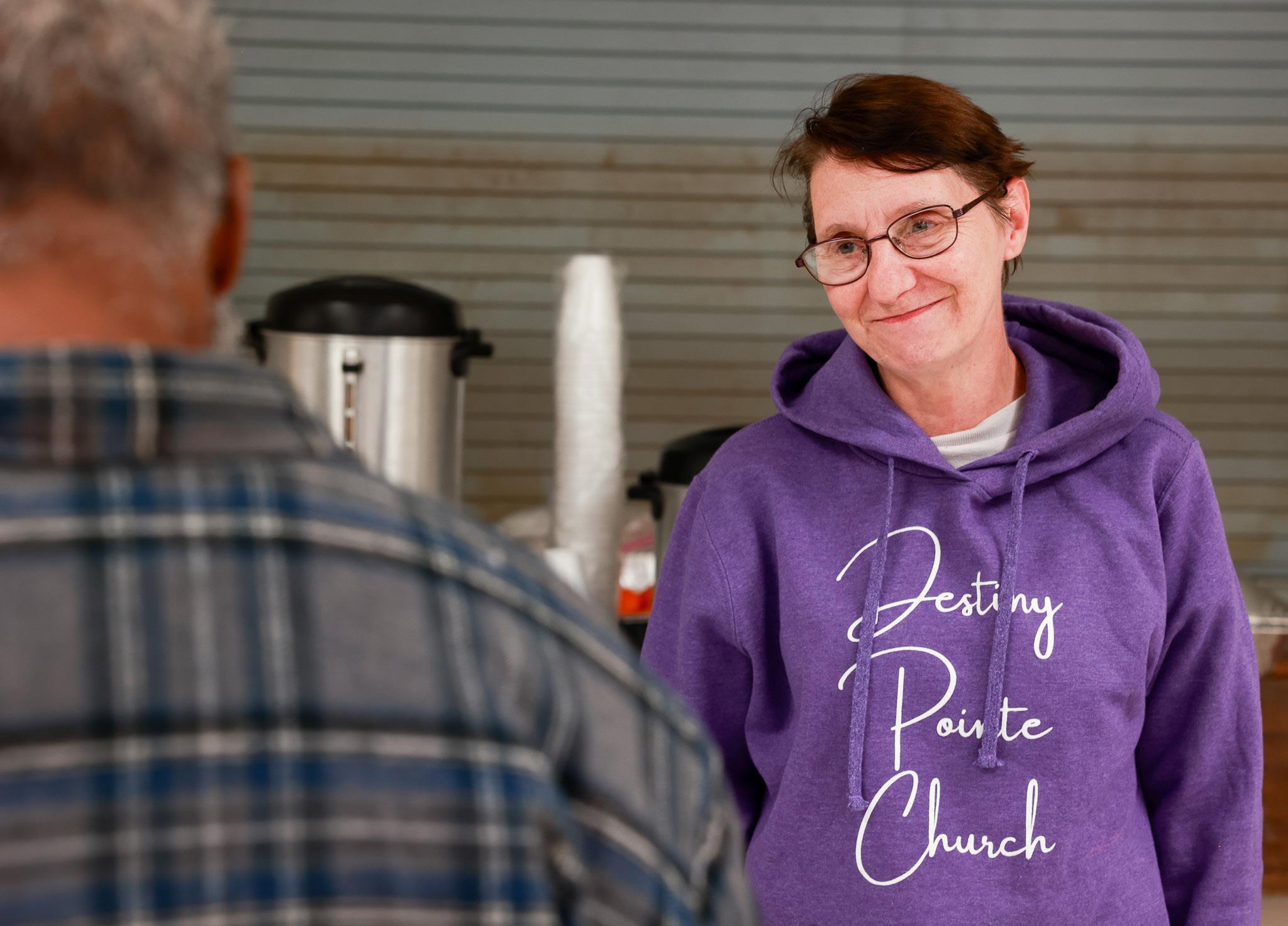
35 CITY LIFE COMMUNITY
Dye serves breakfast to Room at the Inn guests. Dye gets to her shift at 4:45 a.m. to have breakfast ready.
Anita Dye’s experience with homelessness and as a guest at Room at the Inn helps her relate to current guests and their day-to-day needs.
TO-DO LIST
Your curated guide of what to do in Columbia this month.
ARTS
Wheel Throwing Date Night
Want to get your hands dirty? Access Arts molds together this night of fun — a no-experiencerequired Wheel Throwing Date Night. It’s an opportunity to mess around with clay and learn a new skill. April 26, 6-8 p.m., $60 per couple, 2109 Cottle Drive, to register visit schoolofservice.org/ date-nights, 573-875-0275
Carmina Burana
Carmina Burana marks the return of the collaboration between the Mareck Center for Dance and the Chorale Arts Alliance after a five-year hiatus. This 1936 cantata intertwines dance and song. April 26 and 27, 7-9 p.m., Jesse Auditorium, $32-$48, mareckcenterfordance.org, 573-219-7134
The Mousetrap
Maplewood Barn Theatre rings in its 51st season with the Agatha Christie murder mystery, The Mousetrap. The 72-year-old play began as a radio play, Three Blind Mice, but was expanded beyond the 20-minute radio show to a full-length play in 1952. Bring a chair and blanket for a play under the stars. May 16-19 and May 23-26, 8 p.m., Nifong Memorial Park, maplewoodbarn.org, 573-227-2276
heel
This sculpture exhibition that opened April 5 at stop-gap projects focuses on the physical body as building blocks and structures. New York artist Coco Klockner portrays the body in abstract ways to emphasize the heel of the foot as a foundational aspect of the body and life. Through May 3, 6-9 p.m., 810 E. Walnut St., stop-gap-projects.com
Dancing with Missouri Stars
Are you a fan of the “Dancing with the Stars” show? The Mareck Center for Dance spins the popular television show into a social event with eight local notables taking a spin on the dance floor alongside professional dancers. Some participants this year include a veterinarian, local business owners and an educator. May 16, 7 p.m., Brewer Fieldhouse inside Mizzou Rec Center, $30, mareckcenterfordance.org, 573-219-7134
CIVIC
Big Derby Party
This event brings the experience of the Kentucky Derby to Columbia while supporting Big Brothers Big Sisters of Central Missouri. While you enjoy traditional Kentucky-style derby pageantry and food, you have a chance to win items from the

36 VOX MAGAZINE •MAY 2024
CALENDAR

cigar draw, wine wall and more. May 4, 3-6 p.m. Country Club of Missouri, individual tickets are $100, bigofcentralmo.org, 573874-3677
FOOD Wine Workshop
Want a local taste of Missouri? The University of Missouri Grape and Wine
Institute hosts a wine-tasting experience featuring food and wine from the Show-Me State. The hands-on experience provides attendees with expert guidance from the institute, which is a partnership between the state’s wine and grape industry and the University of Missouri. May 13, 9:30 a.m. to 12 p.m., 154 Eckles Hall, 1400 Rollins St., $25, register at gwi@missouri.edu
Compass Inc.’s Intergenerational Rock Band Choir will perform April 28 at The Blue Note.
MUSIC
Benny Green
As part of the “We Always Swing” Jazz Series, Benny Green will once again perform at Murry’s, this time in support of his latest recording, Solo. The Bay Areanative has made a name for himself with his skills as a pianist over his four-decade career. April 28, 3:30 and 7 p.m., $20-$50, Murry’s, wealwaysswing.org, 573-4424969
Intergenerational Rock Band Choir
Come rock out to Compass Inc.’s Intergenerational Rock Band Choir as the ground presents 12 pop and rock songs from the 1950s to today. This family friendly event features community members from the ages 8 to 80. April 28, 6 p.m., The Blue Note, $6, $10 bar-level tables and opera box, thebluenote.com, 573-874-1944
Gimme Gimme Disco
Grab your paisley bell bottoms for this ’60s dance party. The Blue Note takes you back in time with the musical icons like





37
VOX MAGAZINE • MAY 2024
Photography by Bradford Siwak/Archive
CALENDAR
Join us April 27 FLOATFORTHEFOODBANK.ORG for e FoodBank

ABBA, Cher, Donna Summers and The Bee Gees to get you on the dance floor. May 3, 9 p.m., The Blue Note, $15, $35 bar-level tables and opera box, thebluenote.com, 573-874-1944
Parker McCollum
The Gold Chain Cowboy is coming to the Mizzou Arena on his Burn it Down tour. He’s known for bringing together country fans and all types of music lovers. If you can’t get enough of Parker McCollum, grab your tickets to hear his songs like “Pretty Heart” and “Handle on You.” May 4, 7 p.m. Mizzou Arena, $21 and up, parkermccollum.com
Kid Disco!
Does the “Baby Shark” jingle run through your head as you try to sleep at night? If your answer is yes, then this event at Rose Park has your family covered. DJ Requiem will play your kids’ favorite tunes and there will be a bounce house and bubble machine. Parents can enjoy food from Delia’s Mexican Grill and drink adult beverages. Future Kid Disco events are planned for June, August and September with an all-access pass for $30. May 5, 10 a.m., Rose Park, $10 family pass for this event, rosemusichall.com, 573 874 1944

Mandy Gonzalez
Mandy Gonzalez will perform in concert with Dan Lipton as part of the University of Missouri Concert Series. Fans of Hamilton might recognize her from playing Angelica Schulyer on Broadway from 2016 to 2022. May 6, 7 p.m., Missouri Theatre, $50-$60, concertseries.missouri.edu
OUTDOORS
Molly’s Miles
This mid-Missouri 5K, 10K and virtual run honors Molly Suzanne Thomas Bowden, who was killed in the line of duty in 2005 at age 26. She served on the Columbia police force for over three years. The run supports families of police officers who’ve died in the line of duty. April 27, 8-10:30 a.m., Molly Bowden Memorial Park,, $20$35 entry fee, mollysmilesrun.com
CoolFest
Want to have fun with all things cool? This event in The Arcade District features live music, a gaming convention, face painting, a Super Smash Bros tournament and other activities. Appearances include BoCoMo Bubble Guy, Show-Me Dinosaurs and Les Bourgeois. May 4, 1-7 p.m., The Arcade District, free, thearcadedistrict.org
38 VOX MAGAZINE •MAY 2024
CALENDAR
Celebrate the diversity that makes America, America. Add your photo to the true portrait of America at lovehasnolabels.com

SAY FREEZE!
PHOTOGRAPHY BY JJ MEASER
It might be too hot to build a snowman, but that didn’t stop dance students at the Mareck Center for Dance from enjoying a Frozen–themed tea party. June Martin, in a purple princess dress and pink slippers, received the red carpet treatment from photographer Sam Johnson during the April event. The tea party was a fundraiser for the Student Scholarship Program and the Dance Reach program, which works to make dance accessible regardless of income. The Mareck Center is hosting another fundraiser, Dancing with Missouri Stars, on May 16.
39 VOX MAGAZINE • MAY 2024
photo finish

PRESENTS

JUNE 22 - JULY 13
The Missouri Symphony welcomes you to the Firefly Music Festival, a reimagined summer festival experience led by MOSY Music Director, Wilbur Lin.
New this year... Festival Passes!
TICKETS & PASSES ON SALE NOW! FOR TICKETS AND MORE INFORMATION, CALL (573) 875-0600 OR VISIT THEMOSY.ORG/FIREFLY

























































































